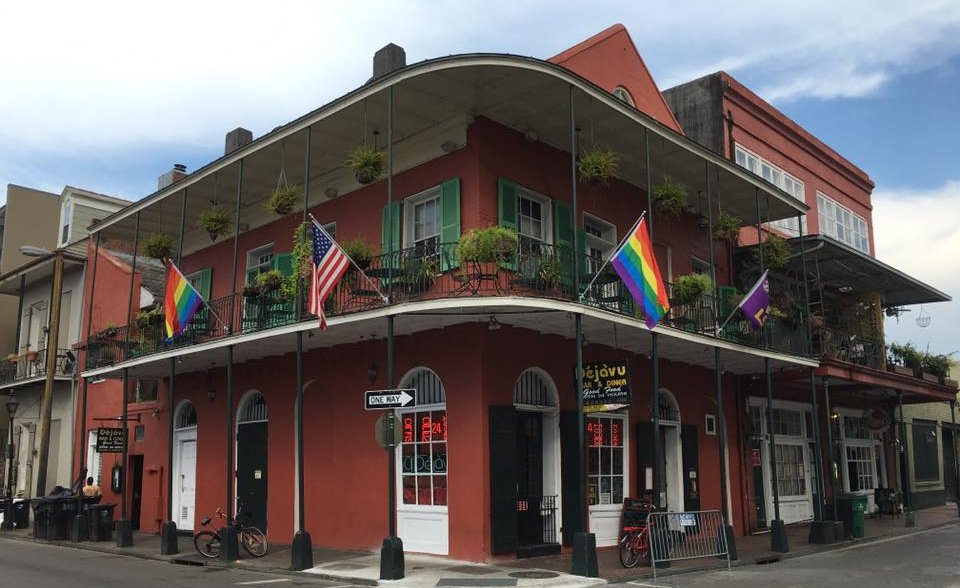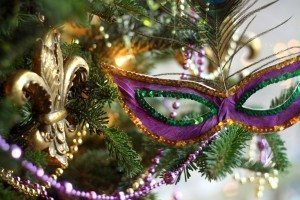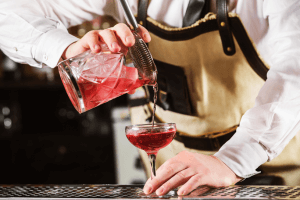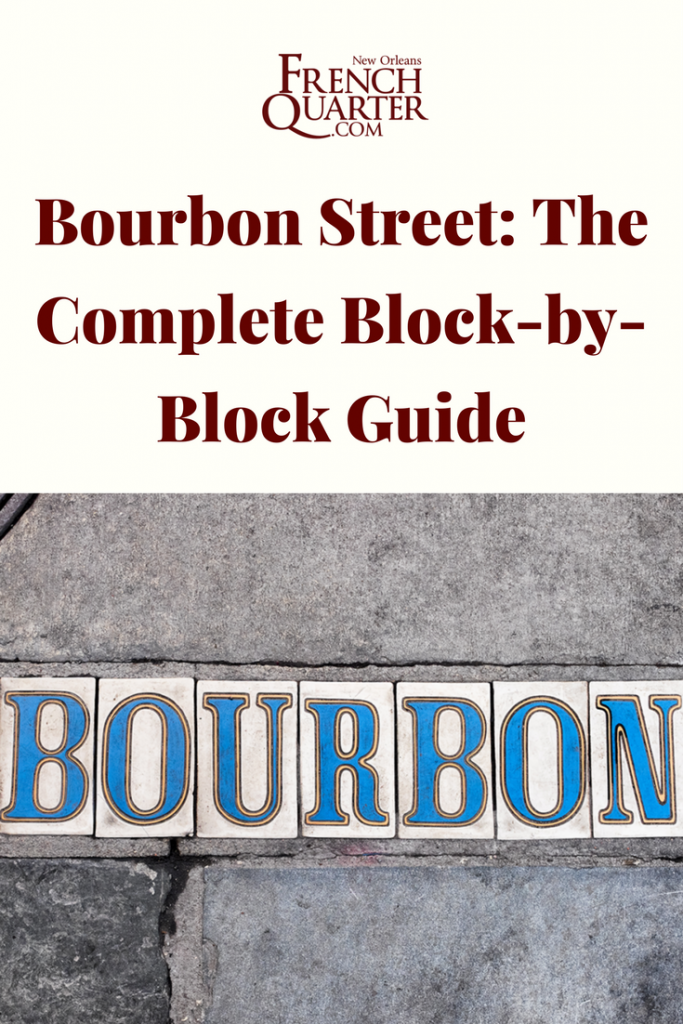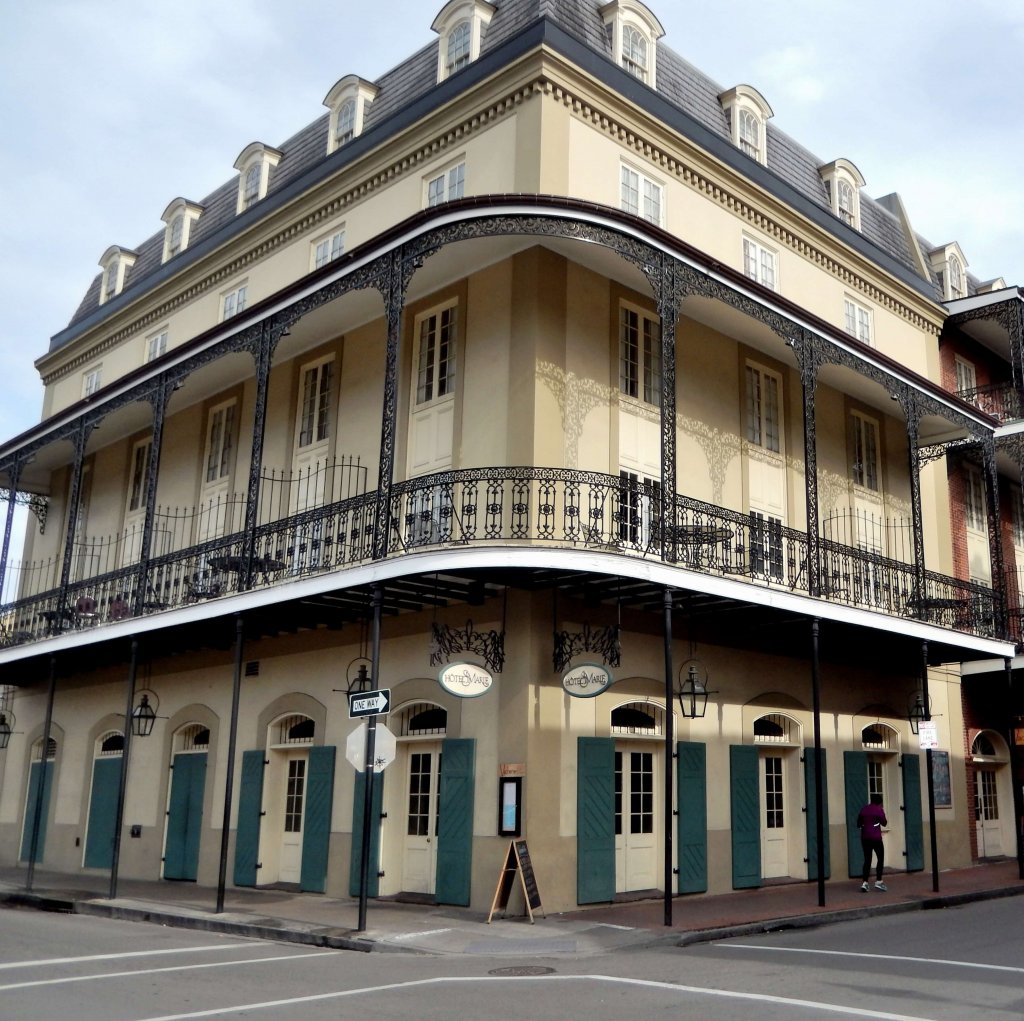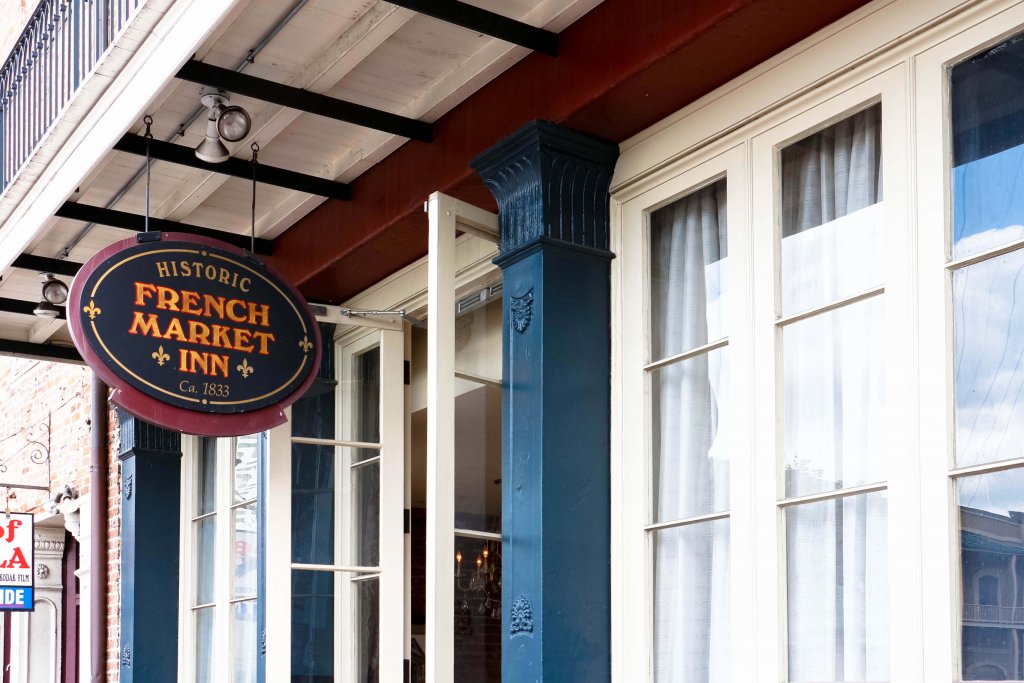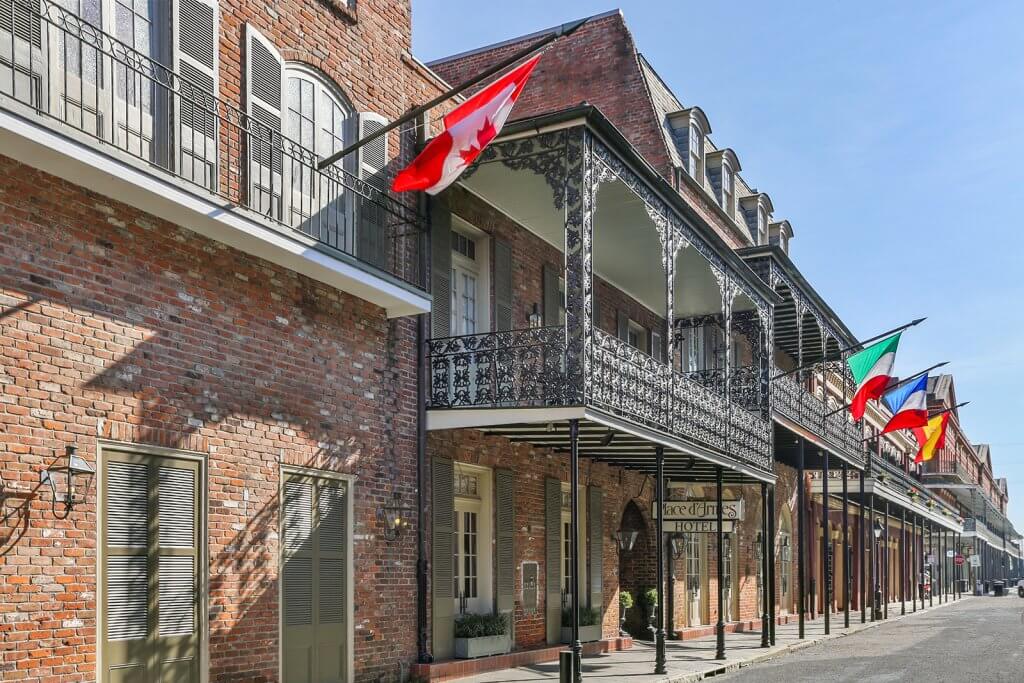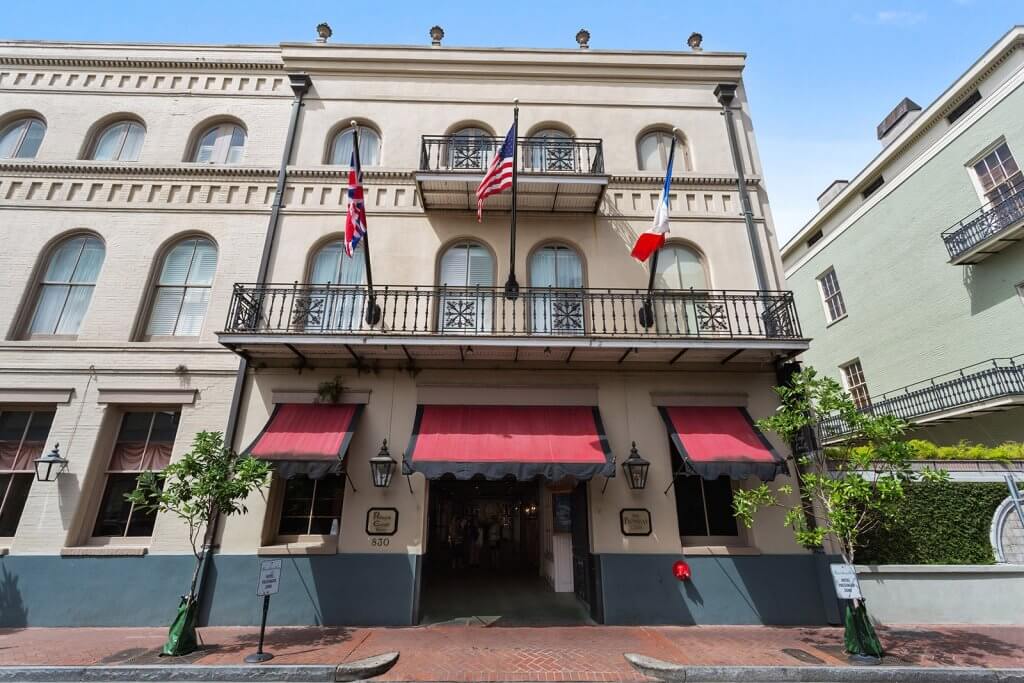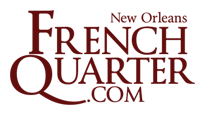Dauphine Street, a Block-by-Block Guide
A dauphine is the wife of the French king’s oldest son — and just as its name suggests, a stroll down Dauphine Street will make you feel like royalty. That’s thanks in part to the standout restaurants that line the elegant (and, yes, regal) corridor. But Dauphine Street is also host to attractions that range from humble to down-out weird. Here are just a few top spots on Dauphine Street.
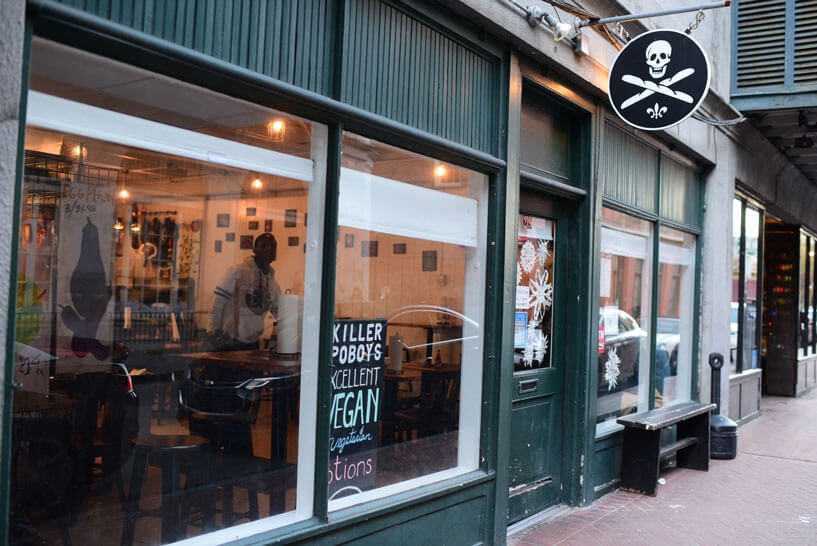
Killer PoBoys
219 Dauphine Street
Killer PoBoys launched as a pop-up in the rear of Erin Rose bar — and the proprietors still sling sandwiches there. But if you want to taste the innovative po-boys in a more expansive environment, this counter-serve restaurant fits the bill. Killer PoBoys expanded to these Dauphine Street digs in 2015, where a steady flow of French Quarter workers, locals and tourists rub shoulders over truly outstanding po-boys. There’s a sweet potato and greens version for the vegan crowd, a cheddar omelet po-boy for breakfast fiends, and a seared Gulf shrimp and sriracha version that has the flavor profile of banh mi. In short, Killer PoBoys has a po-boy for every palate (the menu changes, so this is just a sample of what to expect).
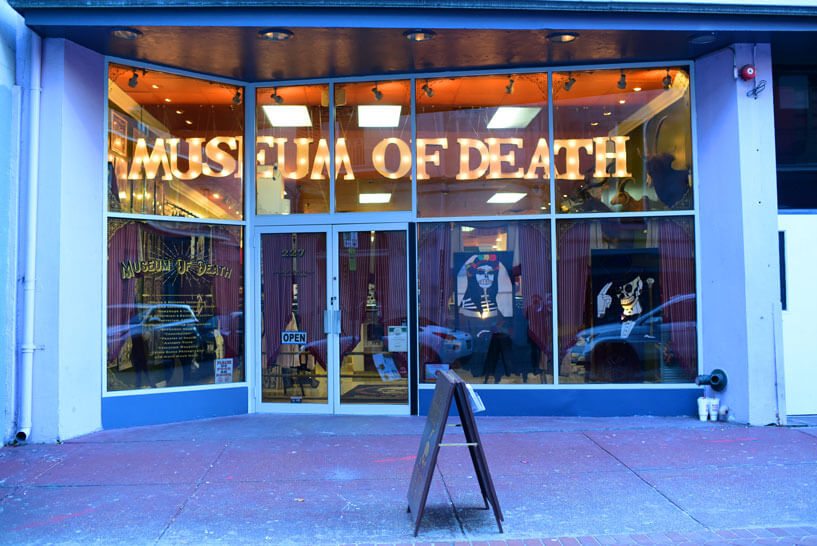
Museum of Death
227 Dauphine Street
What better place to contemplate your mortality than the most haunted city in the United States? The Museum of Death offers creepy, oddball, and downright disturbing artifacts and paraphernalia. Shrunken heads, mortician equipment, serial killer letters, graphic crime scene footage, and more fill the space. This morbid museum may be a little too intense for children, as well as some adults.
Deja Vu Restaurant and Bar
400 Dauphine Street
This full-service restaurant and bar in the French Quarter is always ready to accommodate. You will find a wide variety of options on the menu ranging from traditional New Orleans fare to downhome comfort food, all reasonably priced. Deja Vu serves breakfast, lunch and dinner all day long and is available for dine-in, carry-out or delivery. Open till 11 p.m. nightly.
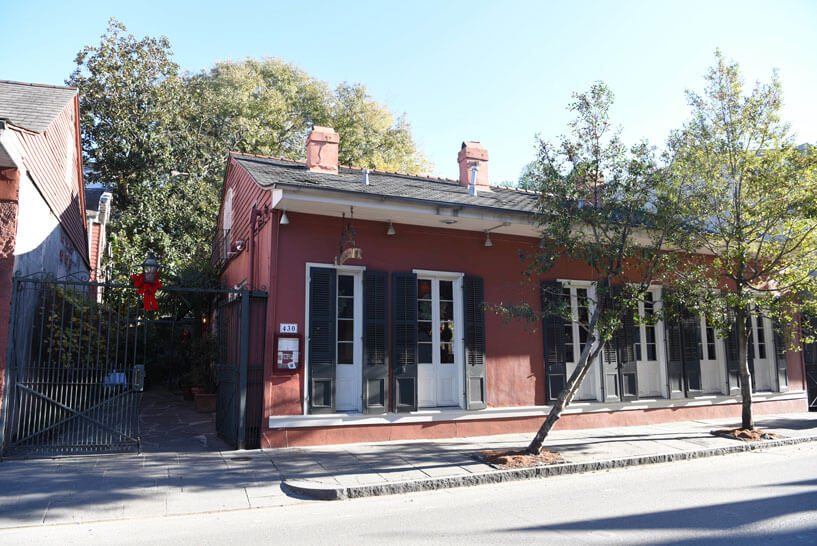
Bayona
430 Dauphine Street
Legendary chef (and James Beard awardee) Susan Spicer has crafted a restaurant empire, racking up accolades from Food & Wine, the John Folse Culinary Institute, the Zagat guide, and many others. Opened in 1990 in a 200-year-old cottage, Bayona is the restaurant that put her on the map. Today, its globally accented Louisiana cuisine feels both classic and forward-thinking.
Good Friends Bar
740 Dauphine Street
Laid back and welcoming, this is the Cheers of French Quarter gay bars. You’ll feel welcome at its mahogany bar (or on its second-floor balcony) whether it’s your first visit or your 50th. P.S. Good Friends is a great place to watch the New Orleans Saints play.
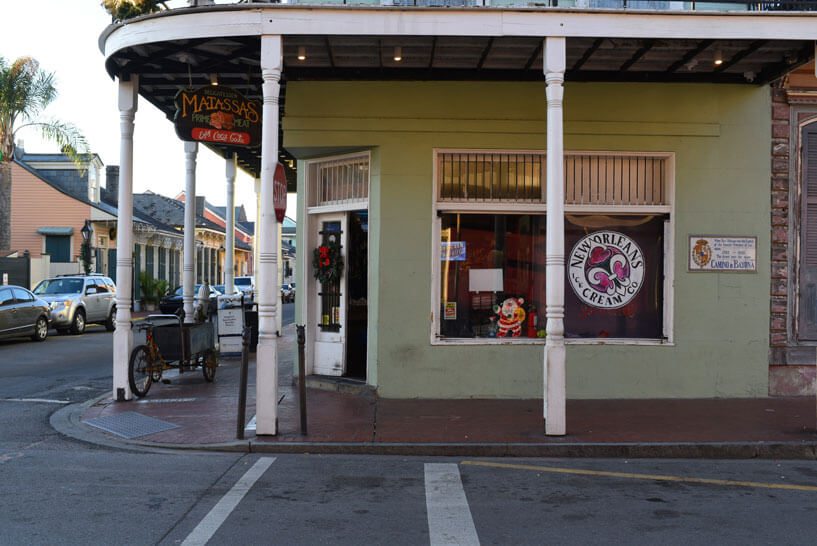
Matassa’s Market
1001 Dauphine Street
It’s an MVP for French Quarter locals and tourists alike: a family-owned market where you can grab everything from a sausage po-boy and a six-pack to paper towels and bananas. Plus, they deliver. Is it any wonder Matassa’s business has been booming since its funding in 1924?
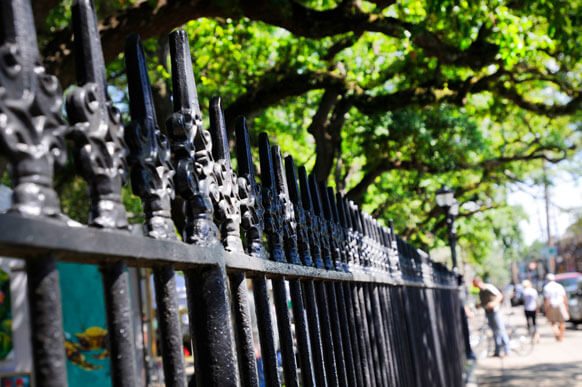
Washington Square Park
Dauphine Street forms the northernmost boundary of this dog-friendly park in the Marigny, where you’ll find playground equipment, shady oak trees, benches, and grassy fields. The 2.54-acre park is a comfortable neighborhood hangout and a great place to unwind. Grab a beer and a hot dog from Dat Dog, or get a latte and a sandwich from Ayu Bakehouse, and enjoy a picnic in the park.
For more, check out our guide to the Famous Streets of the French Quarter.
Also, are you planning to spend some time in New Orleans soon? To stay close to all the action, book a historic boutique hotel in the French Quarter at FrenchQuarter.com/hotels today!
All photos except Deja Vu are by Cheryl Gerber
Related Articles
JOIN THE NEWSLETTER!
Burgundy Street, a Block-by-Block Guide
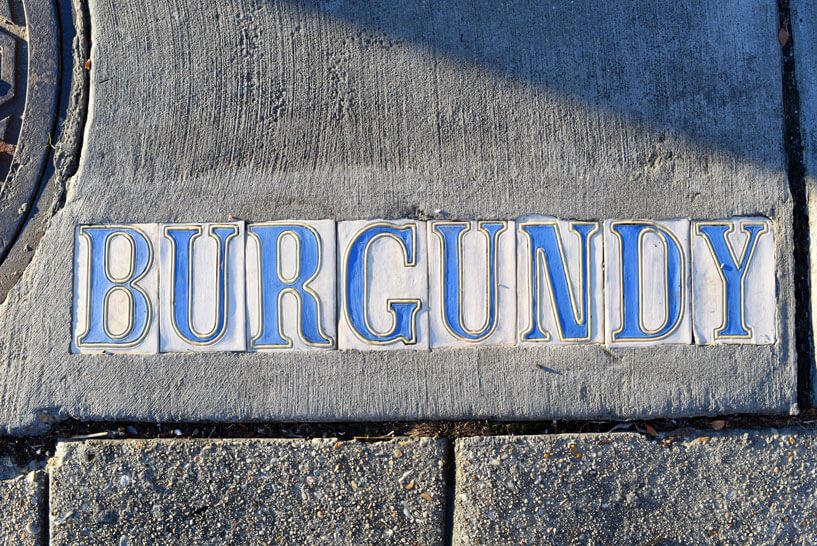
The French Quarter is many things: a historic site, a shopping and entertainment district, a premiere food and drink destination, and, to many tourists, an adult Disneyland. But for roughly 369,749 New Orleanians, according to the 2022 Census, the French Quarter is home.
Nowhere is it easier to remember that the Vieux Carre is a living, breathing neighborhood than on Burgundy Street. Unlike Bourbon Street, with its daiquiri bars and strip clubs, or Royal Street, with its antiques shops and boutiques, Burgundy Street is lined with the down-home essentials that make the French Quarter livable.
From parks to bars, Burgundy Street is the place to go if you want to live like a local. Here are a few of our favorite neighborhood hangs.

French Quarter Wedding Chapel
333 Burgundy Street
From cake pulls to second lines, New Orleans has rich wedding traditions, which is just one reason so many couples plan destination weddings in the Big Easy. But for spur-of-the-moment nuptials, this petite, 24-hour wedding chapel fits the bill. Reverend Tony Talavera (Rev. Tony) can waive the 72-hour waiting period that usually accompanies a wedding license application, so you can get married on the spot.
Whether you want a 20-minute ceremony or a two-hour affair that includes a violinist, photography, second line, and hankies for 50 guests, there’s a package for every price and preference. You can also get a “specialty reverend” (Elvis, vampire, Wicca, or voodoo). It’s no wonder more than 15,000 people have gotten hitched here.
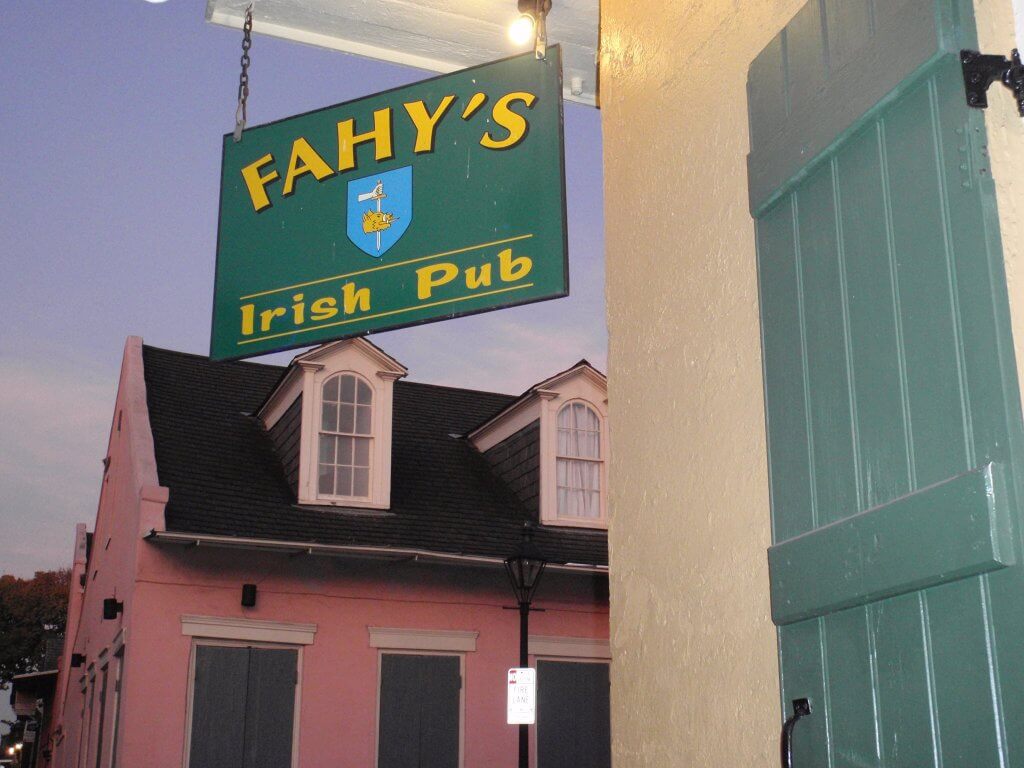
Photo courtesy of Fahy’s Irish Pub on Facebook
Fahy’s Irish Pub
540 Burgundy Street
Fahy’s is a decidedly local scene, especially after restaurants and other bars begin ending their shifts for the night. The popular drink at Fahy’s is a local version of the “mind eraser,” a sweet vodka concoction served in a pint glass and slurped quickly by two or more people simultaneously through straws in a race to the bottom. Pool is very popular here, as evidenced by the rows of small, wooden lockers for regulars to stow their personal pool cues and gear.
Rawhide Lounge
740 Burgundy Street
This down-to-earth gay leather bar has daily happy hours, pool, a jukebox, a laid-back vibe, and adult videos on TV. Although Rawhide (you might hear referred to it as The Silver Fox) bills itself as a craft cocktail bar, the prices are reasonable. There’s also a dance floor with an abundance of disco balls. You can’t beat the location, either.
Quarter Grocery & Deli
836 Burgundy Street
Along with sundries and alcohol, this unassuming convenience store also has a deli with sandwiches and po-boys. How great is that? Especially since the French Quarter isn’t exactly teeming with convenience and grocery stores.
Cabrini Playground
931 Barracks Street
Although its official address is 1219 Dauphine Street, this fenced playground backs up to Burgundy Street. If you’re traveling with kids, it’s a must-stop and a great place to let little ones burn off excess energy. Slides, climbing equipment, jungle gyms, grassy fields, and more are all available at this neighborhood park. You can also walk your dog there, as long as your furry companion is on the leash.
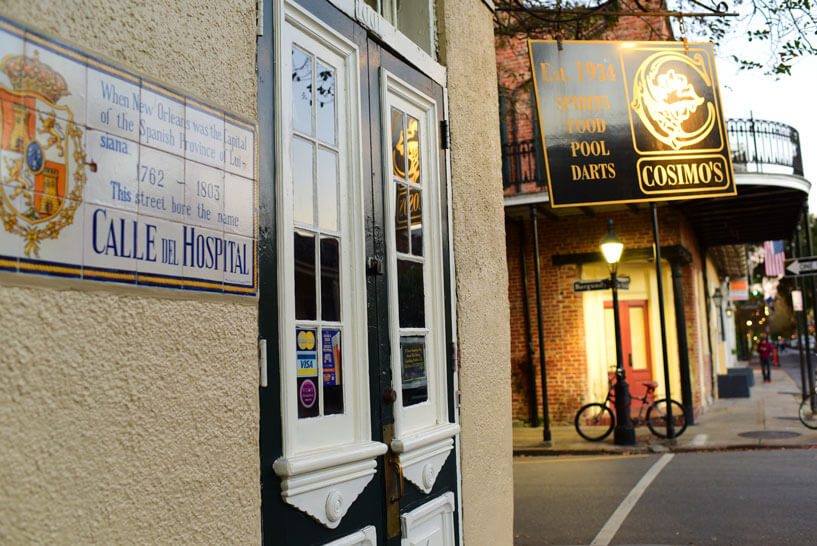
Cosimo’s
1201 Burgundy Street
This dim, dog-friendly neighborhood hang is just the place when you’re in the mood for a pint and conversation in a laid-back environment. During crawfish season, you might get lucky and stumble upon one of Cosimo’s boils, and the bar serves top-notch pub grub year round. It’s a great place to take in a New Orleans Saints game, too. Plus, there are pool tables, Pac-Man and pizza — what more could you need?
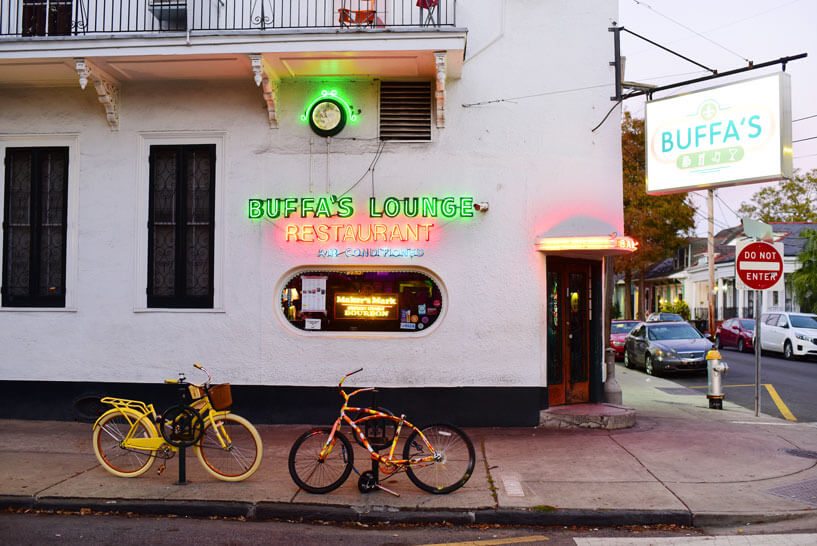
Buffa’s
1001 Esplanade Avenue (where Esplanade Avenue meets Burgundy Street)
A neighborhood staple since 1939, this beloved neighborhood destination isn’t so much a dive bar as it is a community center. On any given night, patrons will find live music, open mics, and more in Buffa’s back room. The menu ranges from classic bar bites (burgers and fries) to Louisiana fare (gator balls and red beans and rice). Plus, there’s breakfast and a Sunday brunch. Another plus — Buffa’s is open (and serves food) till 2 a.m. every night. Buffa’s is technically located in the Marigny, but it’s right across the street from the French Quarter, so it’s good enough of a reason to recommend it.
Ruby Slipper Cafe
2001 Burgundy Street
Looking for brunch? Cross over into the Marigny and hit up The Ruby Slipper, a local chain serving Louisiana-tinged breakfast staples, such as barbecue shrimp and grits or banana pecan pancakes. Plus, there’s a full bar. Just don’t get there too late — this popular spot attracts a weekend crowd and long waits.
For more, check out our guide to the Famous Streets of the French Quarter.
Also, are you planning to spend some time in New Orleans soon? To stay close to all the action, book a historic boutique hotel in the French Quarter at FrenchQuarter.com/hotels today!
All photos except Fahy’s Irish Pub are by Cheryl Gerber
Related Articles
JOIN THE NEWSLETTER!
Famous Streets of the French Quarter
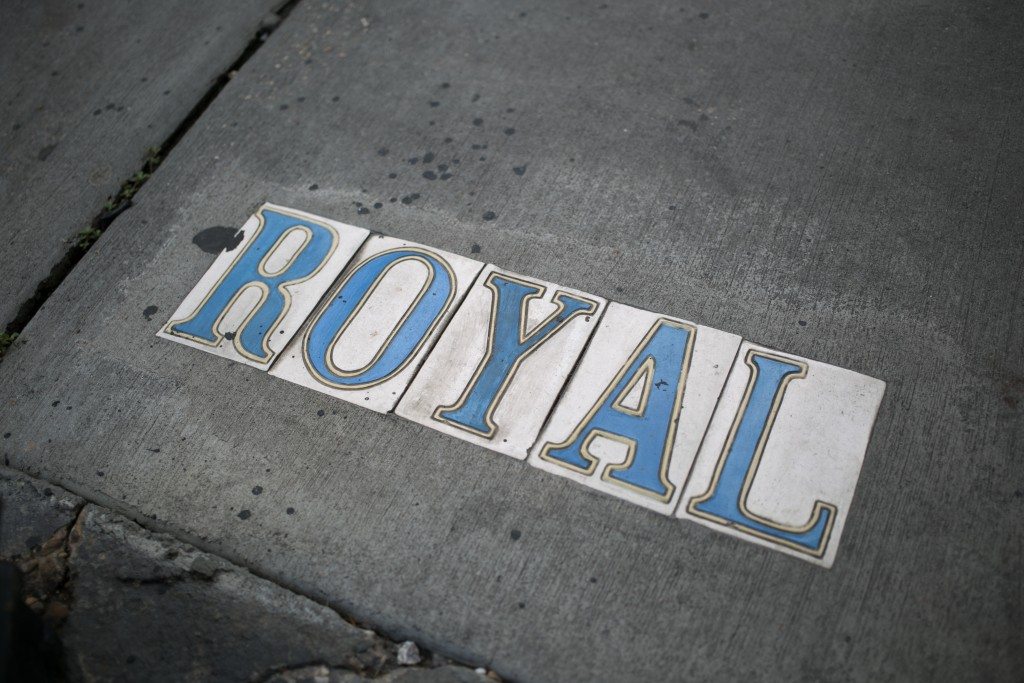
Royal Street by Trevor Mark
When French cartographer Adrien de Pauger laid out the Vieux Carre’s orderly grid in 1721, he envisioned the St. Louis Cathedral as the city’s center. While its Jackson Square location does remain a hub of activity, a modern 21st-century visitor would be hard-pressed to define the Quarter’s center: is it the St. Louis Cathedral, Bourbon Street, bustling Canal Street, or somewhere else? Regardless, we think de Pauger would be proud to see New Orleans thriving over the centuries. Here are a few renowned streets in the French Quarter and what you’ll find there.
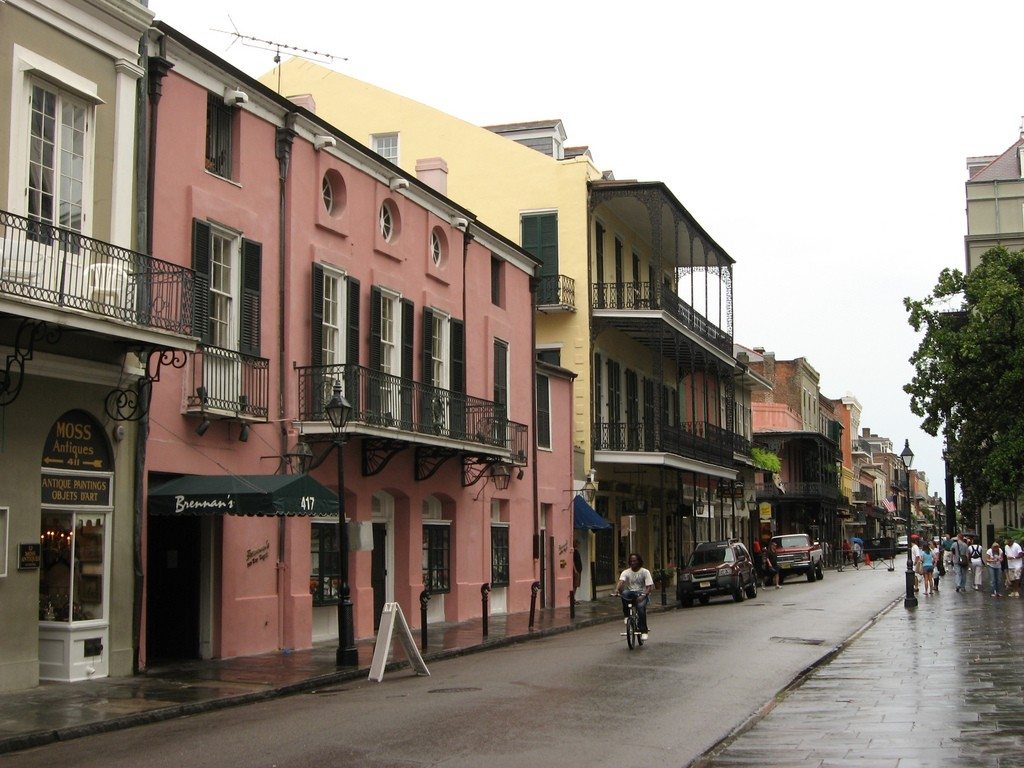
Royal Street Between St. Louis and Conti streets. Photo courtesy of Ken Lund
Royal Street
Art galleries, antique shops, fine dining, and fantastic live music — that’s what you’ll encounter on this charming thoroughfare, which runs parallel to Bourbon Street but feels light years away. Some sections are fenced off to form pedestrian malls (don’t bike through these areas — you will be ticketed). Must-stops include the George Rodrigue Studios, dining at Brennan’s, and antiquing at M.S. Rau. Read our block-by-by guide to Royal Street for more spots for sightseeing, dining, drinking, and more.
Bourbon Street
No, it’s not named after booze — though you wouldn’t be the first person to assume so. Pauger actually named Bourbon Street for the French ruling family of the time, the House of Bourbon. Today, Bourbon is the site of a 24/7 party that must be witnessed to be believed. Don’t miss an elegant show at The Jazz Playhouse, a decadent meal at Galatoire’s, and a stiff drink at Lafitte’s Blacksmith Shop. For many more recommendations, read our block-by-block guide to Bourbon Street, the Bourbon Street Bucket List, and the Best Food on Bourbon Street.
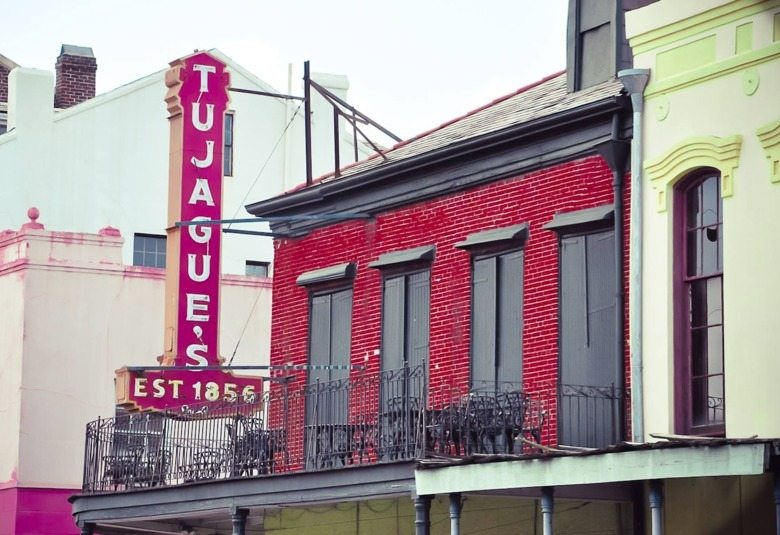
Photo courtesy of Tujague’s Restaurant on Facebook
Decatur Street
Decatur Street is a little more locals-friendly, a little more down-to-earth, and in its lower (nearer to Esplanade Avenue) blocks, more laid back than the rest of the Quarter. It borders Jackson Square and Café Du Monde, but if you continue past the iconic beignet destination, you’ll find Tujague’s, the second-oldest restaurant in New Orleans. A little further down, you’ll find Café Envie, a delightful, breezy coffee shop with sidewalk seating. Follow Decatur past Esplanade to land smack dab in the middle of the Marigny Triangle, surrounded by the city’s best music venues and bars. Read our block-by-block guide to Decatur Street for our top recommendations on what to see, do, and eat and drink on Decatur Street.
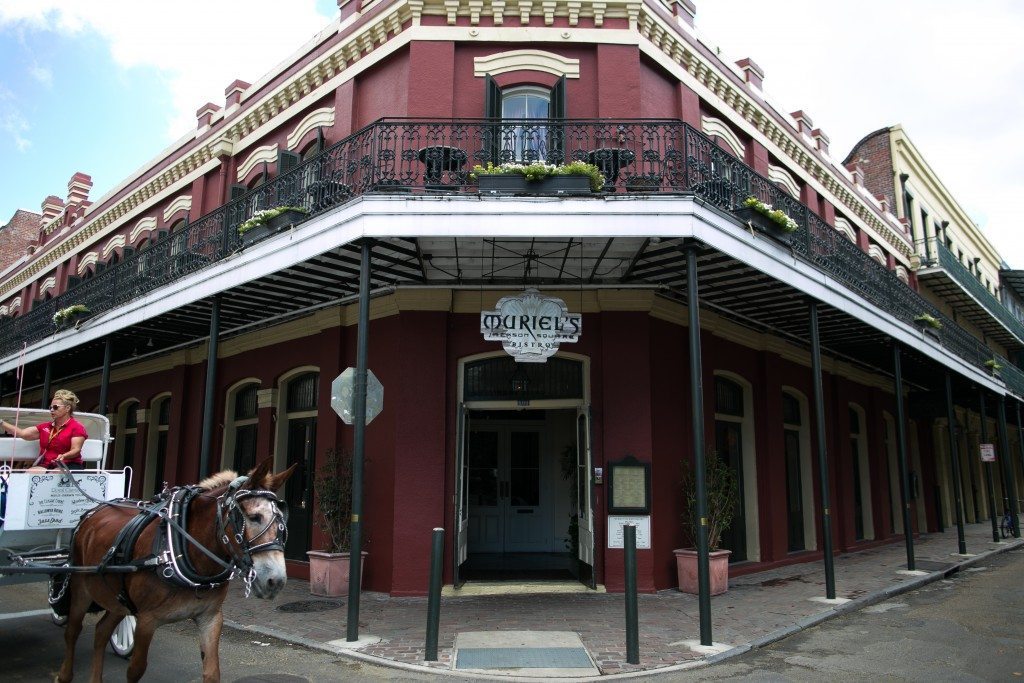 Chartres Street by Trevor Mark
Chartres Street by Trevor Mark
Chartres Street
This pleasant street is lined with boutiques, restaurants, galleries, and souvenir shops, and cuts right through Jackson Square. Visit these must-see museums — the New Orleans Pharmacy Museum, The Cabildo, and The Presbytère. In the mood for shopping? Browse Crescent City Books, Shoe Be Do, Hemline, and UAL. Once you’ve worked up an appetite, enjoy a meal at Muriel’s Jackson Square, Sylvain, Kingfish, and loads more renowned dining destinations. Read our Chartres Street, a Block-by-Block Guide for more inspiration.
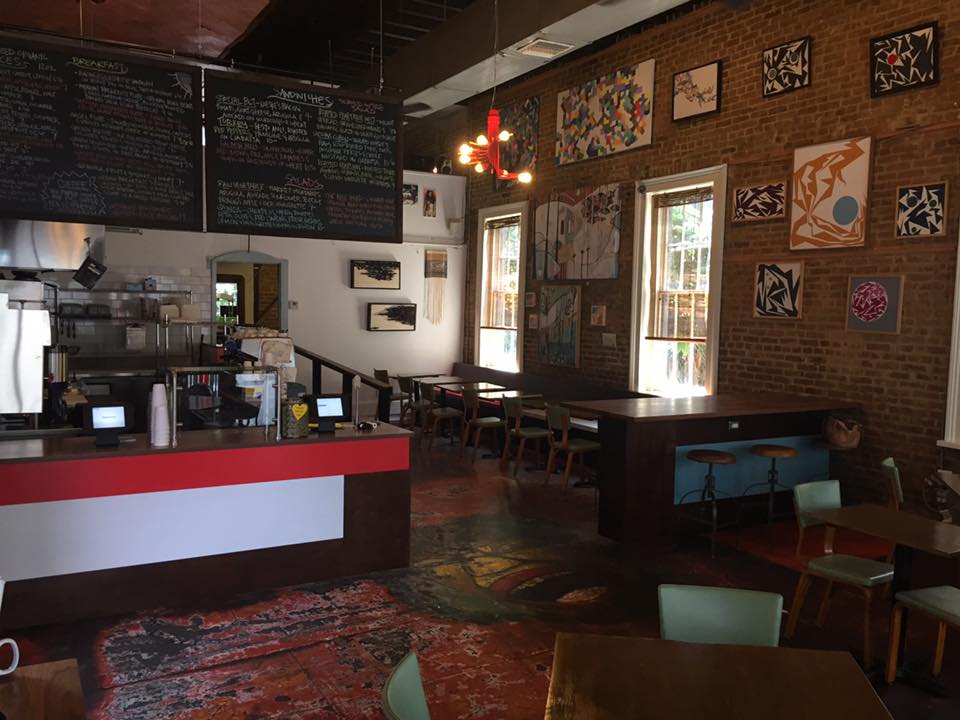
Photo courtesy of Satsuma Cafe on Facebook
Dauphine Street
Named for a dauphine, the wife of a French royal heir titled a dauphin, this regal street hosts plenty of great bars and clubs, especially if you follow it a few miles downstream into Bywater. There, you’ll find the lovely breakfast and lunch destination, Satsuma, a music hub and dive bar extraordinaire, Vaughan’s Lounge, and more to explore. Read our Dauphine Street, a Block-by-Block-Guide for much more.
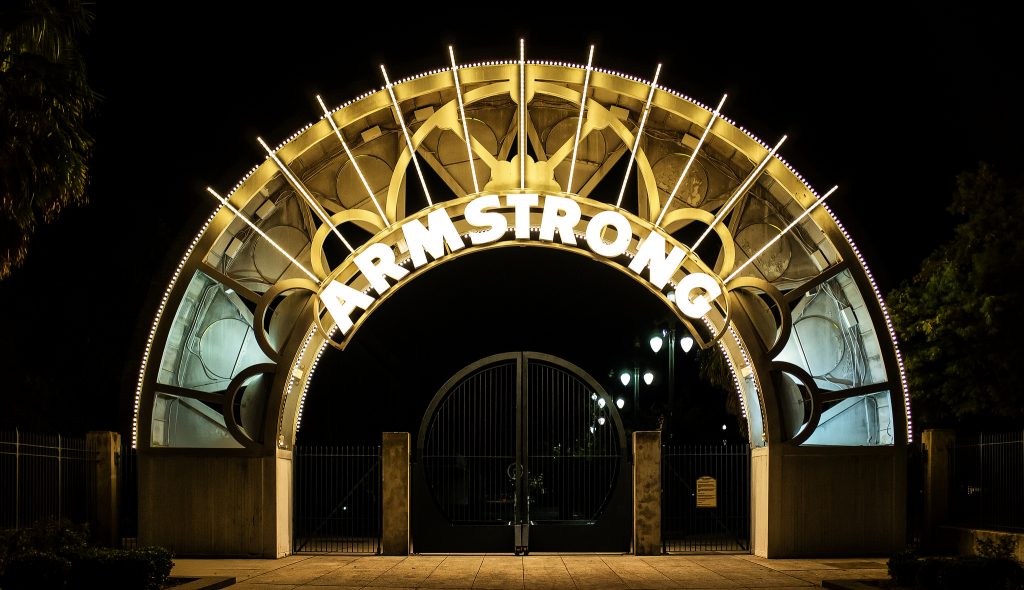
Armstrong Park by Nigel Burgher on Flickr
North Rampart Street
The western border of the French Quarter, Rampart Street is named for the barricades that guarded the former French colony. Today, it features numerous bars and restaurants (don’t miss the Black Penny and Bar Tonique for cocktails). It also hosts an entrance to Armstrong Park, a leafy, fountain-filled tribute to Satchmo himself, which is also the site of the Mahalia Jackson Theater and the historic Congo Square. Recently, a streetcar line was reinstalled on Rampart Street, which runs all the way from Canal Street to Elysian Fields. Read our North Rampart Street, a Block-by-Block Guide for more fun details.
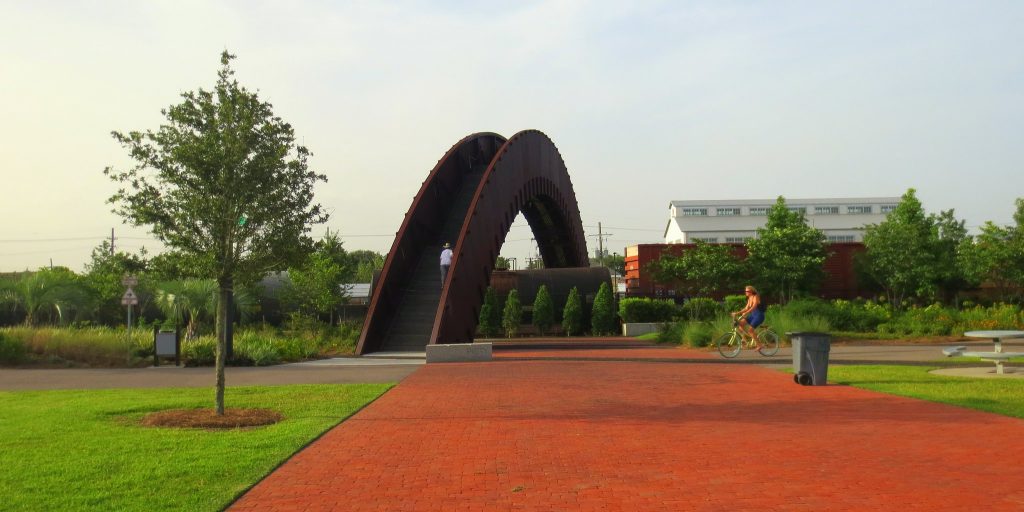
Crescent Park, Bywater. Photo courtesy of Bridget Coila on Flickr
North Peters Street
Need a breath of air? Walk along North Peters Street, which borders the Mississippi River and its Moonwalk. At the very edge of the Quarter, near North Peters and Elysian Fields, you’ll find a staircase and elevator leading to Crescent Park. The 1.4-mile linear park boasts running trails, gardens, and the best view of the river and downtown skyline you’ll find anywhere.

Photo by Cheryl Gerber
Burgundy Street
Nowhere is it easier to remember that the Vieux Carre is a living, breathing neighborhood than on Burgundy Street. Unlike Bourbon Street, with its daiquiri bars and strip clubs, or Royal Street, with its antiques shops and boutiques, Burgundy Street is lined with the down-home essentials that make the French Quarter livable. From parks to bars, Burgundy Street is the place to go if you want to “live like a local.”
First off, some of our favorite hangs are located on Burgundy. The two standouts are Fahy’s Irish Pub and Cosimo’s. Fahy’s is a decidedly local scene, especially after restaurants and other bars begin ending their shifts for the night. The popular drink at Fahy’s is a local version of the “mind eraser,” a sweet vodka concoction served in a pint glass and slurped quickly by two or more people simultaneously through straws in a race to the bottom.
This dim, dog-friendly neighborhood hang Cosimo’s is just the place when you’re in the mood for a pint and conversation in a laid-back environment. The bar serves top-notch pub grub year-round. It’s a great place to take in a New Orleans Saints game, too. Plus, there are pool tables and pizza — what more could you need?
The Quarter Grocery & Deli is an unassuming convenience store with sandwiches and po-boys, along with sundries and alcohol. How great is that? Especially since the French Quarter isn’t exactly teeming with convenience and grocery stores.
Got young kids or dogs? The fenced Cabrini Playground, which backs up to Burgundy Street with an official address of 1219 Dauphine Street, is a great place to let little ones burn off excess energy. Slides, climbing equipment, jungle gyms, grassy fields, and more are all available at this neighborhood park. You can also walk your dog there as long as your furry companion is on the leash. To get more details on what you can find on Burgundy Street, check out our Burgundy Street, a Block-by-Block Guide.
So, are you planning to spend some time in New Orleans soon? To stay close to all the action, book a historic boutique hotel in the French Quarter at FrenchQuarter.com/hotels today!
Related Articles
JOIN THE NEWSLETTER!
Bourbon Street, a Block-by-Block Guide
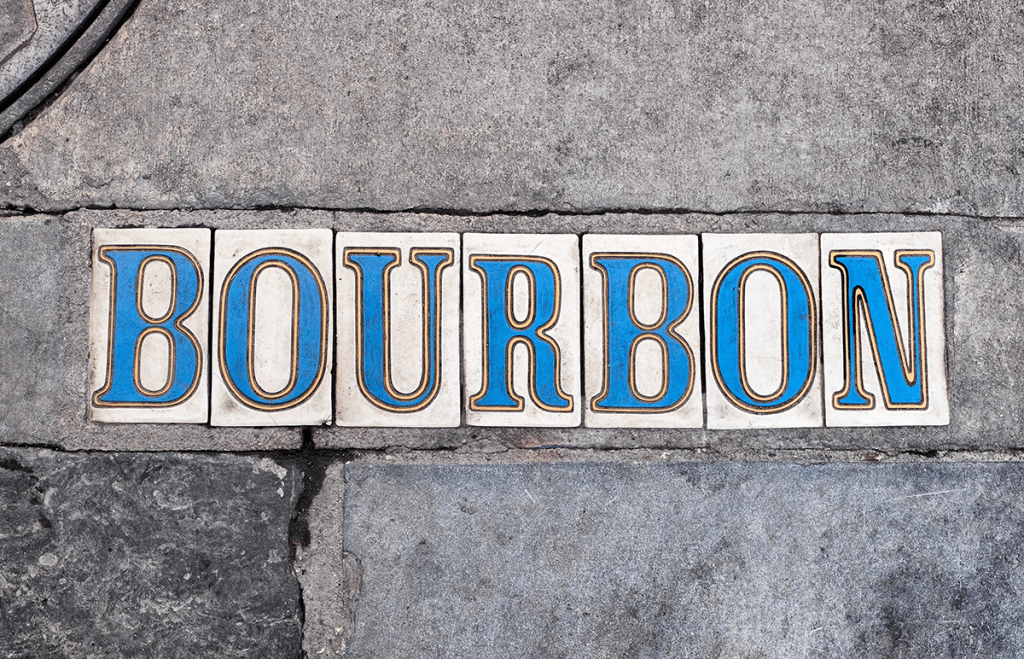
This street is a tourist destination for a reason. It’s a thoroughfare with an utterly fascinating history, and home to some of the oldest bars, family-run restaurants, and gay entertainment districts in the country. In short, while there’s plenty to discover off of Bourbon, there’s a lot to discover on the iconic street as well that may surprise you.
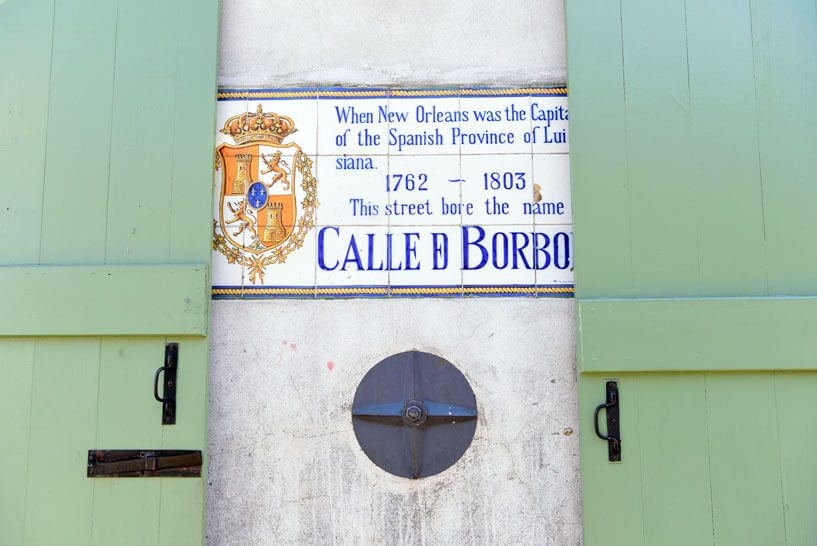
Photo by Cheryl Gerber
A Brief History of Bourbon Street
Let’s start, appropriately enough, with the history of one of the oldest streets in North America. First, despite popular rumors to the contrary, Bourbon was not named for bourbon. That particular iteration of brown liquor had not even been invented when the street was laid out in 1721 by Adrian de Pauger. The street, then located in the colony of New France, was named after the French royal House of Bourbon (which bourbon, the drink, was ultimately named for).
Like much of the French Quarter, Bourbon Street’s historic architecture owes far more to Spain than France as most of the street’s French buildings were destroyed in the Great New Orleans Fire of 1788, when the city was a Spanish colony. For most of its history, Bourbon was a modest residential street, populated by a mix of Creoles (New Orleanians of Franco-Spanish descent) and the successive waves of immigrants who settled the French Quarter.
Bourbon began morphing into an entertainment strip in the late 19th and early 20th centuries, when the Red Light District of Storyville was established a few blocks away on Basin Street. Bleed-over from the Red Light District begot a shift in the Quarter, which became less residential and more entertainment-oriented.
The earliest “jass” (i.e. jazz) artists weren’t headlining festivals in Montreal or Switzerland — they played for customers who patronized Basin and Bourbon Street’s sweaty brothels and music halls (on a side note, those music venues stopped being quite as sweaty when they started installing round-the-clock air-conditioning about half a century later — some of the first nightlife spots in the world to take that step).
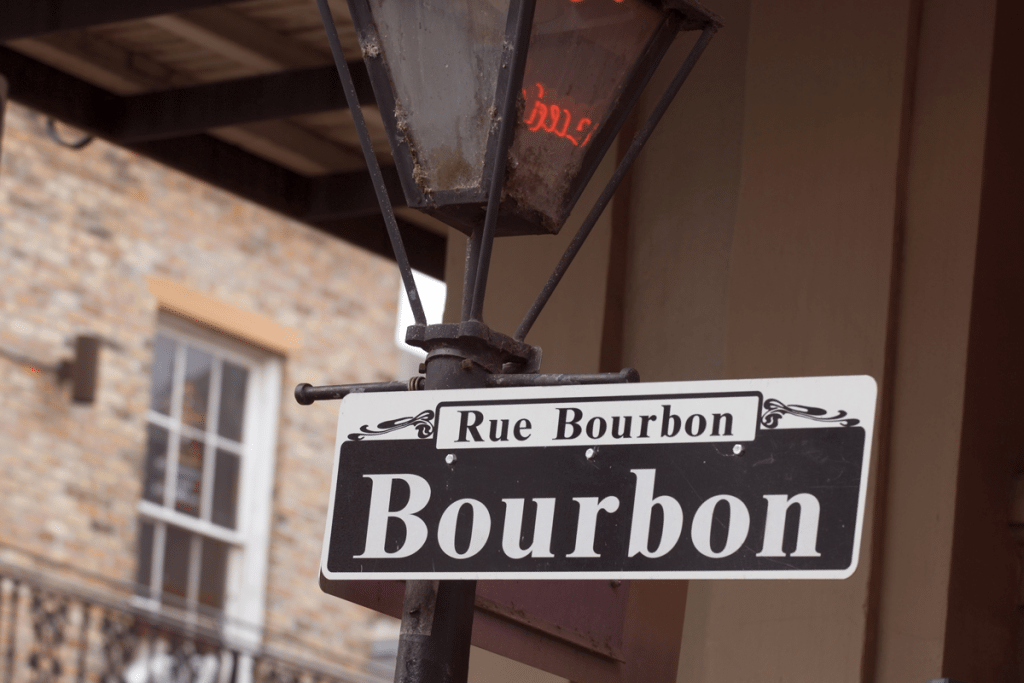
Ironically, the shuttering of Storyville’s brothels in 1917 likely accelerated the French Quarter’s popularity as a place to party. At the time, Mayor Martin Behrman said, “You can make it illegal, but you can’t make it unpopular,” and while the “it” he referred to was prostitution, the legal nightlife that surrounded that practice quickly filled the Red Light vacuum.
In the Quarter, the entertainment focus shifted to live music, gambling, burlesque shows, and drinking establishments, dozens of which opened on Bourbon. By the post-World War II period, Bourbon Street was similar in character, if not appearance, to the Bourbon Street of today, although live music was more heavily emphasized back in the day. The Meters played here, as did Dr. John and Louis Prima, among dozens of other acts that have defined successive generations of American music.
While there are still live music clubs on Bourbon, those venues have tended to spread into other parts of the city. On the other hand, Bourbon remains a nightlife epicenter for the New Orleans LGBTQI+ scene, which established a presence here in the early 20th century, when the area had (more of an) “anything goes” reputation. In the present day, while the LGBTQI+ culture is thankfully accepted across the city, the “Lavender Line” on Bourbon and St. Ann streets still marks one of the country’s most fabled gay nightlife blocks.
The Geography of Bourbon Street
Bourbon Street runs 13 blocks through the heart of the French Quarter, from Canal Street to Esplanade Avenue; it becomes Carondelet Street past Canal, and Pauger Street past Esplanade. If you were looking at a map, Bourbon runs along a diagonal; confusingly to visitors, the “southern” part of Bourbon (near Canal Street) is Upper Bourbon, while the “northern” end (near Esplanade) is Lower Bourbon. In New Orleans parlance, Upper and Lower refer to the upriver and downriver flow of the Mississippi. If all of the above is confusing, don’t worry — it’s more trivia than vital geographic knowledge.
Upper Bourbon is the area best known to visitors — the land of neon, roaming bachelor and bachelorette parties, strip clubs, and enormous drinks served in souvenir cups. Lower Bourbon has most of the above, but not in such intense concentration; it includes the LGBTQI+ blocks of Bourbon.
While this is not the exhaustive list of every business and attraction on Bourbon (some even may or may not be here tomorrow), here are some of our favorite hangouts, running from Canal to Esplanade. You’ll notice that this guide mostly covers iconic, well-established and most popular restaurants. For more details on where to eat and drink on Bourbon Street, check out our guides to the “Bourbon Street Bucket List” and “Best Food on Bourbon Street.”
The 100 Block of Bourbon Street
Bourbon House (144 Bourbon Street)
The Bourbon House is one of the city’s grand dame, old-school seafood houses. Run by the Brennan family restaurant empire, they serve excellent raw oysters, decadent Gulf seafood platters, and one of the truly great iterations of barbeque shrimp. Their version is cooked in a buttery sauce that is balanced by a generous helping of rosemary.
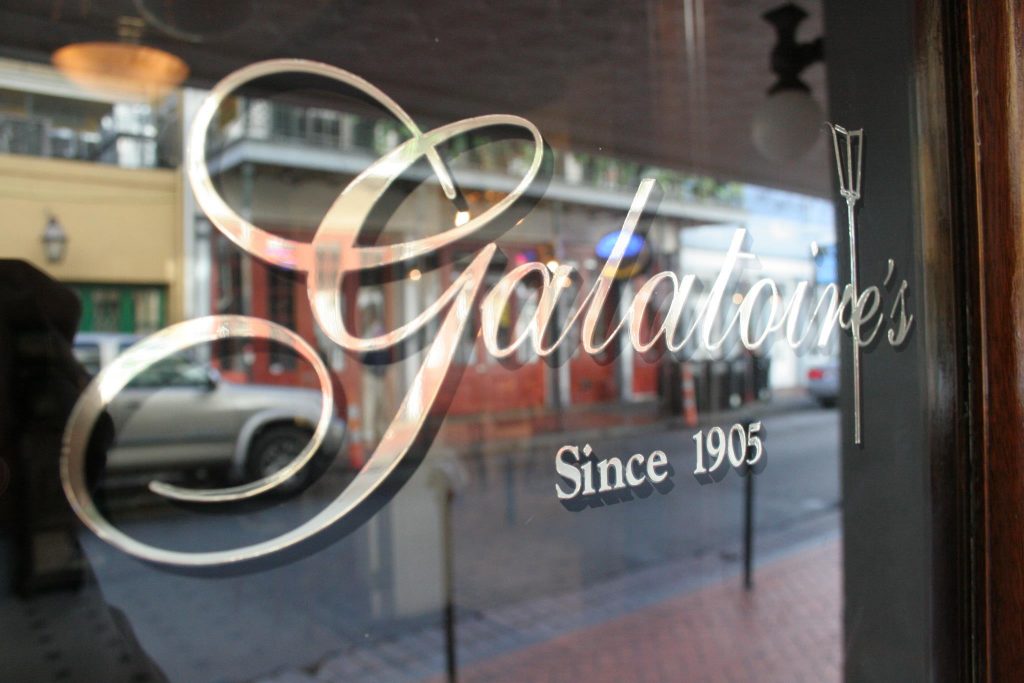
Photo courtesy of Galatoire’s on Facebook
The 200 Block of Bourbon Street
Olde Nola Cookery (205 Bourbon Street)
If you’re in the market for something simple and noticeably New Orleans, and you’re wandering around the 200 block of Bourbon, Olde Nola Cookery is a good choice. We always have time for barbeque shrimp, which is not grilled or smoked, but rather cooked in a lemon butter and pepper sauce. Plenty of gumbo and Cajun pasta dishes round out the menu.
Galatoire’s (209 Bourbon Street)
Stepping into Galatoire’s is stepping back in time; the restaurant opened its doors in 1905, and not much seems to have changed since (our understanding is they only started accepting credit cards in the ‘90s). The cuisine is old-school, heavy Creole classics — chicken Clemenceau and crabmeat sardou — but folks come for the scene as much as the food. On Fridays, the oldest of old-school New Orleans families line up around the block (or pay people to wait in line for them) and engage in daylong drinking and dining sessions. It’s a spectacle for sure.
Galatoire’s “33” Bar and Steak (215 Bourbon Street)
For decades, nothing changed at Galatoire’s, one of the grandest of old New Orleans restaurants. Then they started accepting credit cards, and eventually, Galatoire’s “33” opened. The times are a-changing, but “33” has the original Galatoire’s charms and its full menu served in the dining room — and it also happens to have some very fine steaks.
Old Absinthe House (240 Bourbon Street)
It’s always a good idea to sidle up to the classic copper bar, and you won’t be the first to do so: The Absinthe House dates to 1806, making it older than most American states, and has hosted Franklin Roosevelt and Oscar Wilde, among other patrons. It can get crowded, but when the bar is (relatively) quiet, we like to order the signature absinthe and dream of boozy days (and famous patrons) past.
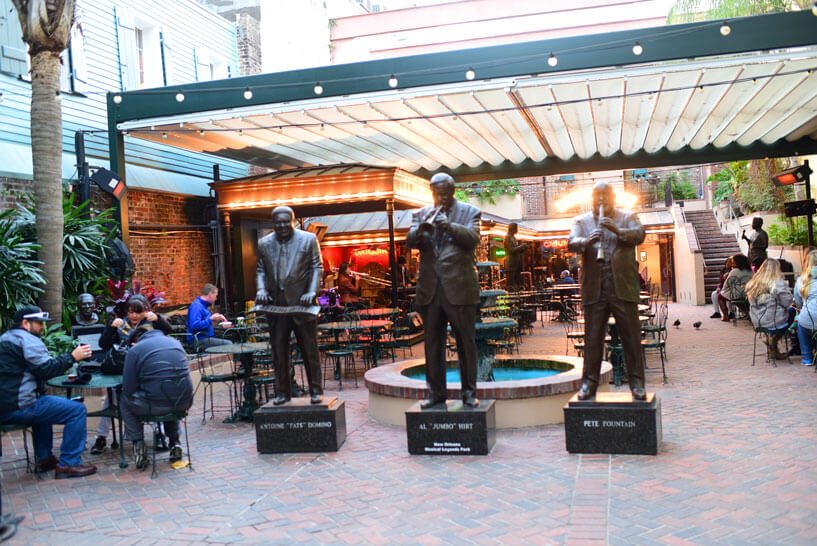
Musical Legends Park by Cheryl Gerber
The 300 Block of Bourbon Street
The Jazz Playhouse (300 Bourbon Street)
This is a legitimately lovely music venue in the heart of Bourbon Street (inside the Royal Sonesta). The lineup is straight unadulterated jazz, and the Playhouse hosts some of the most talented and exciting acts in the country.
New Orleans Musical Legends Park (311 Bourbon Street)
Life-size statues of local musical legends line this park, which is a (sort of) quiet respite from the noise and thrum that lines this portion of Bourbon.
The 400 Block of Bourbon Street
Hideout Bar (417 Bourbon Street)
The Hideout Bar has a speakeasy vibe, courtyard seating, live music, and serves the kind of New Orleans/Southern fare you just might be craving after some revelry (think meat pies and boudin balls). Open till 1 a.m. every night.

Tropical Isle by Cheryl Gerber
The 500 Block of Bourbon Street
The sadly now-shuttered iconic club owned by the late, great Chris Owens dominates the block. In August 2022, Gayle Benson, the owner of the New Orleans Saints and Pelicans, bought the three-story building and plans to renovate and lease the property.
The 600 Block of Bourbon Street
Tropical Isle (600 Bourbon Street)
Besides the Hurricane, the Isle’s signature Hand Grenade is the most famous drink in the French Quarter. They taste like candy but are very potent. Tropical Isle also has locations at 435, 610, 721, and 727 Bourbon Street.
SLUSH Frozen Cocktails (601 Bourbon Street)
The historic building hosted a popular live music venue called the Old Opera House until it closed. Back in the day, it was a real French-style opera house. The most current tenant is a daiquiri bar that specializes in alcoholic slushies, popsicles and milkshakes, plus serves pizza by the slice. SLUSH is open till 2 a.m. Sunday through Thursday and till 3 a.m. on Friday and Saturday. It has another location at 401 Bourbon Street.
Marie Laveau’s House of Voodoo (628 Bourbon Street)
This is one of our favorite tourist voodoo shops. The walls are adorned with masks, gris-gris bags, spell candles, and all kinds of other cool magical paraphernalia. Check out the handmade voodoo dolls fashioned from Spanish moss, and have yourself a consultation — these folks are true believers.
Krazy Korner (640 Bourbon Street)
Longtime bar, club and live music venue with jazz, rhythm and blues plus a balcony, Krazy Korner is located on the corner of Bourbon and St. Peter streets. Over the years, it served as a hangout for the recording artists and is still a great place to catch some live New Orleans music.
Maison Bourbon (641 Bourbon Street)
The sign outside the door says, “Dedicated to the preservation of jazz,” and Maison Bourbon does not disappoint in this regard — it’s a good spot for a live show. It also has a lovely courtyard and a big balcony.
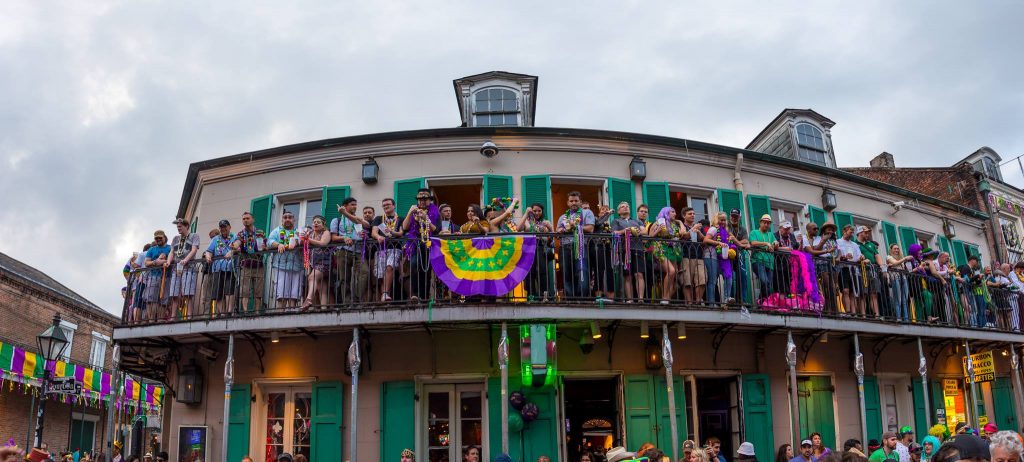
Photo courtesy of Cat’s Meow on Facebook
The 700 Block of Bourbon Street
Cat’s Meow (701 Bourbon Street)
You’ve never heard “Sweet Home Alabama” until it’s belted out by a crowd at the Meow. We have to give this spot credit: It was an early adopter of karaoke, back when people sneered at the idea of karaoke in a bar. The Meow’s enormous popularity is proof of the success of a then-risky business idea. It was so successful that the business open another location on the same block, at 735 Bourbon St.
Pat O’Brien’s (718 St. Peter Street/600 block of Bourbon Street)
While the address for Pat O’s is technically on St. Peter Street, you can enter the bar complex in the middle of the 600 block, right next to Willie’s Chicken Shack. Inside, you’ll find one of the most attractive courtyards and bars in the French Quarter, which is a pleasant surprise for a lot of visitors. There are also dueling pianos. Take a seat, enjoy the tropical ambiance, and order a specialty drink — the Hurricane, of course. The drinks may be sweet, but we’re not going to sugarcoat this next bit of advice: beware the Hurricane hangover.
Bourbon Street Honky Tonk (727 Bourbon Street)
One of the five locations of the Tropical Isle chain with potent drinks and, as you might have guessed from the name, live country music.
Bourbon “O” Bar (730 Bourbon Street)
“Bourbon Street” and “quiet bar that serves craft cocktails” aren’t two concepts that seem to jive, but Bourbon “O” manages to pull it off. OK, maybe it’s not always quiet, but the drinks are gorgeous and well-prepared, which is a welcome development at this stage during our Bourbon Street stroll. Look for it inside the Bourbon Orleans Hotel.
Fritzel’s European Jazz Pub (733 Bourbon Street)
Fritzel’s is a good spot for live jazz and well-prepared iconic New Orleans drinks. They regularly feature plenty of old-school Dixieland. It’s calm and laid back in almost inverse proportion to much of the rest of Bourbon Street — a great stop if you’re feeling overwhelmed by all the crowds, or if you just want to listen to some good music. That said, evening shows tend to get more packed, so if you want to avoid it, consider a daytime show.
Ra Shop #14 (739 Bourbon Street)
This smoke shop carries smoking accessories, CBD, e-sigs, vaporizers, and more. The chain has 14 location total, including five in New Orleans — two Uptown and two in the French Quarter.
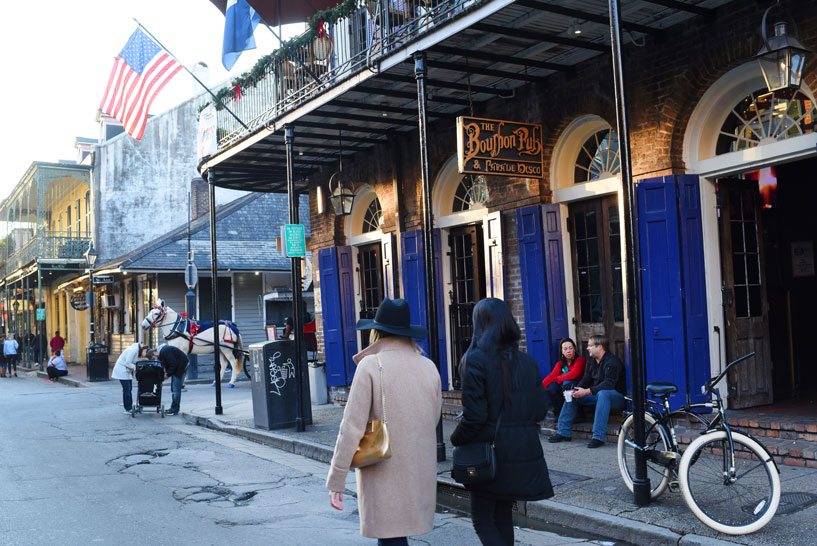
Bourbon Pub & Parade by Cheryl Gerber
The 800 Block of Bourbon Street
Oz (800 Bourbon Street)
The corner of Bourbon and St. Ann streets is known as the “Lavender Line,” which marks the beginning of the LGBTQI+ section of Bourbon Street (you may also be subtly tipped off by the enormous rainbow flags). Oz is one of the more popular gay dance clubs in the city, so expect drag queens, shirtless dancers, and all the rest.
Bourbon Pub Parade (801 Bourbon Street)
A late-night nightclub with two balconies, dance floors, shirtless folks on the bar, drag queens, and a lot of unsa-unsa. It serves as one of the focal points of the annual Decadence fest. Being around since 1974, the iconic club is celebrating its anniversary in 2024.
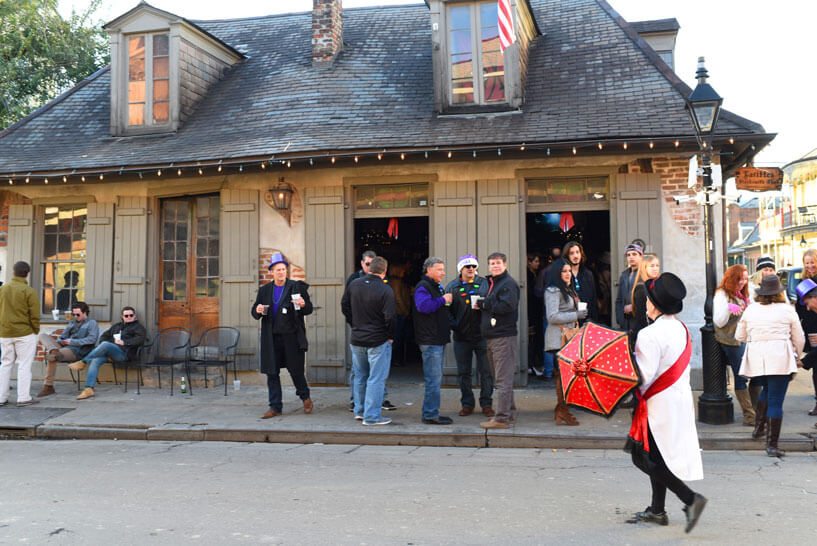
Lafitte’s Blacksmith Shop by Cheryl Gerber
The 900 Block of Bourbon Street
Clover Grill (900 Bourbon Street)
The Clover is one of our favorite 24-hour diners in New Orleans (on a side note, there aren’t a ton of 24-hour diners in this city, which is a shame). The food is great, but we really come for the atmosphere, which is a heady mix of drag queens, off-work servers, bartenders, hotel staff, tourists, and musicians all hunkering down for burgers and scrambled eggs at three in the morning. Clover Grill’s motto is “We Love to Fry and it Shows.”
Lafitte’s (901 Bourbon Street)
The self-proclaimed oldest continually operating gay bar in the country is open 24/7, and features karaoke nights, disco parties, and a huge wraparound bar and balcony. Established in 1933, at the end of Prohibition, Lafitte’s is said to have been frequented by Tennessee Williams and Truman Capote. Because of its location and plentiful outside seating, Lafitte’s is a hub of activity for both Mardi Gras and Southern Decadence in particular.
Lafitte’s Blacksmith Shop (941 Bourbon Street)
One of our favorite Bourbon Street haunts, this Lafitte’s (not to be confused with Lafitte’s, above) operates out of the oldest building that has served as a bar in the country. It looks the part, too; the walls are all moldering stone and wood, although the scene is pretty modern: there’s a piano bar and the signature “purple drank,” a frozen daiquiri that can quickly end your night (or get it started).
For more, check out our guide to the Famous Streets of the French Quarter.
Also, are you planning to spend some time in New Orleans soon? To stay close to all the action, book a historic boutique hotel in the French Quarter at FrenchQuarter.com/hotels today!
Related Articles
JOIN THE NEWSLETTER!
Brief History of the French Quarter
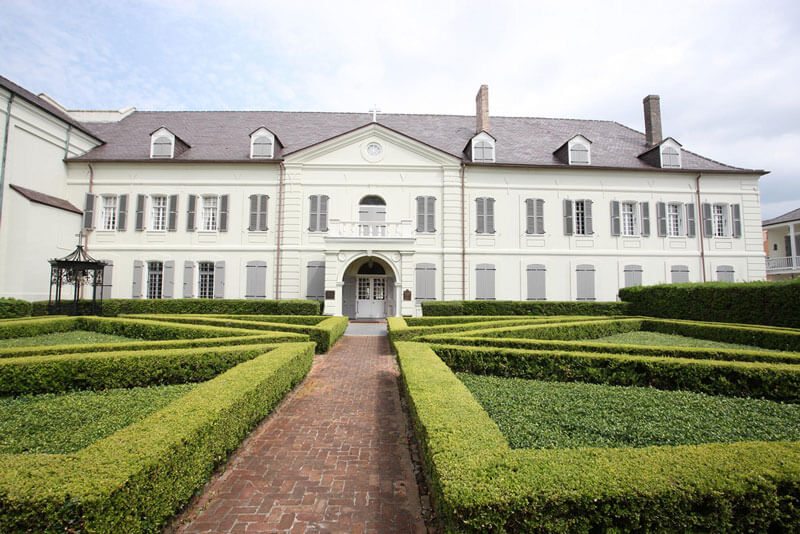
We cover a lot of local festivals and other events, as well as attractions and things to see, do, eat, and experience in the French Quarter and nearby. But, with the city’s 300-year-plus history, how did we get here? What transpired in those years, and who were the people who shaped the history of this amazing melting pot of a neighborhood? Let’s go over the complex history of the French Quarter.
Well, they don’t call this neighborhood the “old square” for nothing. The French Quarter was the original city of New Orleans, founded in 1718 by Jean-Baptiste Le Moyne de Bienville. Rampart Street is named as such because it once marked the actual city walls (or ramparts) of New Orleans. The city centered on Place d’Armes, now known as Jackson Square, was originally built as a military parade ground where criminals were hanged in public.
The name “French Quarter” is a bit of a misnomer; New Orleans was under Spanish rule from 1762 to 1802, and it was during this period that two huge fires (in 1788 and 1794) seared away much of the original architectural facade of the Quarter.
Thus, the buildings you see today retain more of a Spanish than French sensibility, as evidenced by wraparound balconies (which create a shady, breezy median space between the street and private residences — a useful architectural trick in hot, pre-AC New Orleans) and lush courtyards painted in bright colors, which form a reflective patina that wards off the sun.
The best example of actual French colonial architecture in the Quarter is the Old Ursuline Convent, which is also the oldest building in the Mississippi River Valley (built in 1752). With that said, the streets of the French Quarter are largely named in honor of French nobility — Burgundy, Chartres, and, yes, Bourbon.
If the French Quarter marks the original layout of New Orleans, then the original inhabitants were the Creoles, people of French, Spanish, and eventually mixed French and Spanish descent. That phenomenon is eloquently realized when one considers the names of two of the main buildings on Jackson Square: the (Spanish-origin) Cabildo and the (French-origin) Presbytère.
It is also worth noting that St. Louis Cathedral, which dominates Jackson Square, is the oldest continuously operating cathedral in the USA, and a fine example of French Colonial architecture in its own right.
Although the Creoles called the French Quarter home for many decades, they began moving out as the area became more depressed and ramshackle, especially in the early 20th century. That was when city officials shut down the vice in the red-light district of Storyville.
In response, the purveyors of sin crossed Rampart Street into the Quarter, and the Creoles moved out, to be gradually replaced by Italian immigrants. Later, also came the bohemians, attracted by the area’s undeniable architectural charms, as well as the members of the LGBTQIA+ community seeking tolerance.
In 1965 the Vieux Carré Historic District was established, allowing for the preservation of the Quarter’s historic character. The 1984 World’s Fair turned the Quarter into a bustling tourism destination, which was around the same time that many residents began leaving the neighborhood.
The Quarter tends to weather hurricanes and storms pretty well. Power lines are built underground, and the neighborhood itself was built on “high ground” (well, a few feet of elevation, but that’s enough) — which keeps it (mostly) immune from flooding. Today, while the Quarter is largely an area for tourists, thousands of residents still call it home.
If you’re planning a stay in New Orleans, be sure to check out our resource for French Quarter Hotels.
Related Articles
JOIN THE NEWSLETTER!
Where to Stay in the French Quarter in 2025
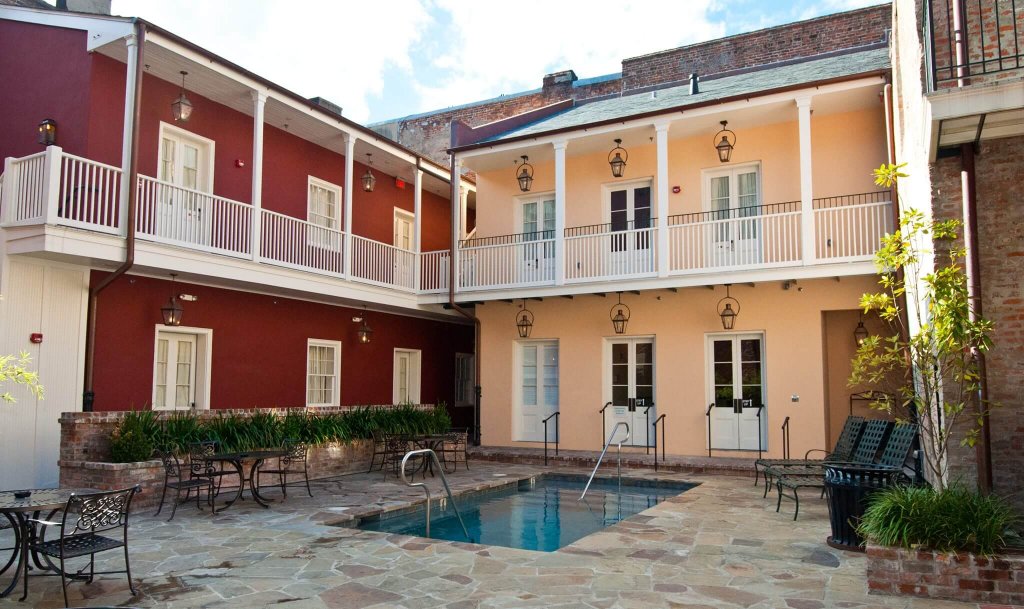
The French Quarter is the heart of New Orleans and a testament to its colorful past, where cultures, music, cuisines, and history create an irresistible tapestry that is pure magic, with a dash of ’round the clock joie de vivre. And what better way to explore this one-of-a-kind place and one of the oldest neighborhoods in the U.S. than to stay right in the middle of the action?
These five boutique hotels are located in and near the French Quarter, so you’re never far from all that the neighborhood has to offer — whether you want to dance the night away to a brass band, take a stroll to take in the breathtaking architecture, or sample every Creole dish you come across.
You can explore the streets of the French Quarter to your heart’s content, and then enjoy the welcome respite from the bustle and relax by the pool, hit a happy hour, or grab a bite in one of the hotels’ bars and restaurants, or simply enjoy the view from your room or your balcony.
Hotel St. Marie
827 Toulouse Street
Hotel St. Marie serves up a classic French Quarter atmosphere with modern amenities. Its European-style decor delivers luxurious touches like chandeliers and period paintings. The meticulously restored exterior is lined with wrought-iron balconies overlooking the action, only half a block away from Bourbon Street and a mere four blocks from Jackson Square and the St. Louis Cathedral.
While Hotel St. Marie still retains its old-world charm, the bathrooms are outfitted with walk-in showers, and other modern amenities were updated. The tropically landscaped courtyard contains a saltwater pool and patio seating.
The on-site, elegant yet low-key Vacherie Restaurant & Bar is three in one: restaurant, bar, and cafe, which are all located next to one another on the first floor. The cafe serves breakfast staples plus snacks, salads, and things like sandwiches, perfect on the go or eaten at the bar. It’s open daily from 7 a.m. to 7 p.m. You can also hit the full bar from 3 p.m. to 11 p.m. The cafe’s menu is served nightly from 4 p.m. to 9 p.m. at the bar.
Standout features: European-style decor with luxurious touches; outdoor pool; tropical courtyard; on-site restaurant, bar, and cafe; recently renovated; half a block away from Bourbon Street.
French Market Inn
509 Decatur Street
French Market Inn is located on a busy block of Decatur Street, just steps away from the Mississippi Riverfront and within six blocks of renowned New Orleans attractions like Jackson Square, the French Market, the Audubon Aquarium and Insectarium, Bourbon Street, and Harrah’s New Orleans Casino. The hotel’s balconies, overlooking Decatur Street, offer great views of the river and the vibrant neighborhood.
This historic hotel boasts a serene, private stone-paved courtyard with a saltwater pool, a fountain, and a beautiful tropical garden. Its antique brick facade opens onto a lobby adorned with period paintings, chandeliers, and columns, with period details throughout the building.
Since this historic property dates back to the 18th century, every guest room has its distinct character. The first property records date as far back as 1722, and it was used in the past as a bakery and a family residence. In the early 1830s, the Baroness Pontalba y Almonaster bought the bakery and the surrounding lots and turned it into an inn. In 1832, the first hauntings were recorded, and to this day the hotel is considered to be haunted.
French Market Inn had undergone renovation in 2015. The on-site PJ’s Coffee has something fresh brewing daily, from 6 a.m. to 9 p.m.
Standout features: Property dates back to the 18th century; period details throughout, including antique brick facade and beamed ceilings in the guest rooms; outdoor saltwater pool; tropical courtyard; on-site cafe; central location a short walk away from the Mississippi Riverfront and blocks away from many French Quarter attractions.
Place d’Armes Hotel
625 St. Ann Street
Place d’Armes Hotel embodies old-world charm inside and out. It occupies two restored historic townhouses dating back to the 18th and 19th centuries, located on a quiet block of St. Ann Street, steps away from Jackson Square (which used to be called Place d’Armes, hence the name).
Guest rooms facing both the street and the courtyard have wrought-iron balconies, and feature exposed brick, conveying the traditional, old-world ambiance of the French Quarter. The hotel’s courtyard is particularly enchanting, showcasing a variety of tropical plants, fountains, and a saltwater pool under the magnolia trees.
Place d’Armes is a popular stop on haunted walking tours, due to the hauntings recorded there after the school burned down on the hotel’s site in the 1800s.
Standout features: Property dates back to the 18th century; central location right by Jackson Square; outdoor saltwater pool; stunning courtyard with patio seating; complimentary continental breakfast.
Prince Conti Hotel
830 Conti Street
The beautifully appointed Prince Conti Hotel sits in the heart of the New Orleans French Quarter and is just steps away from the non-stop party of Bourbon Street and the shopping and dining destinations of Canal and Royal Streets. It is housed in a historic 19th-century townhouse, which sports a carriageway and plenty of European charm.
Some of its rooms feature exposed brick and four-poster beds, and renovations were held to update the amenities and the interior’s rich colors and moldings, adding touches of opulence and the classic New Orleans charm. Despite its proximity to the 24/7 action right outside its windows, Prince Conti Hotel offers a quiet respite from it all, an oasis with an elegant yet relaxed vibe.
The on-site Cafe Conti has a casual breakfast and lunch menu from 7 a.m. to noon, with a focus on French and Creole cuisines. There you’ll find sweet and savory crepes, eggs Benedict, and local favorites like breakfast po-boy, shrimp and grits, and Croque Madame.
The Bombay Club & Martini Bistro is tucked away down the carriageway at the back of the Prince Conti Hotel. It has more than 50 specialty cocktails on the menu and although it specializes in martinis it also has an extensive selection of single malt scotches, ports, reserved bourbons, and premium cigars.
The Bombay Club is also a popular choice for the nightly local live music, including jazz and cabaret performances. The Bombay Club’s beautiful courtyard is the perfect spot to relax and unwind after a long day of sightseeing or exploring the city.
The food menu features a variety of gastropub items, New Orleans cuisine, and Indian-inspired dishes that play on the bar’s British theme. From classic pub fare like fish and chips to more exotic offerings like BBQ Sticky Ribs to charcuterie boards, there are plenty of globally inspired options. Whether you’re a cocktail connoisseur, a cigar aficionado, or simply looking for a great spot to enjoy some live music and good food, The Bombay Club is not to be missed.
Standout features: Central location and proximity to Canal and Bourbon Streets; historic European charm with luxurious touches like four-poster beds; on-site cafe serves breakfast and lunch; the on-site restaurant has a full bar and live music.
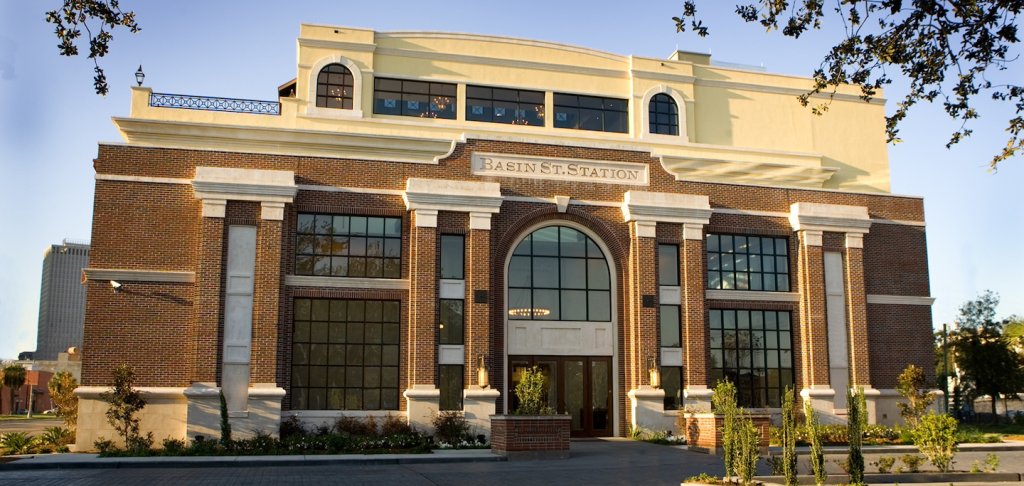
The Brakeman Hotel
501 Basin Street
The Brakeman is Valentino Hotels’ latest exciting boutique hotel located in Basin St. Station, the original Norfolk Southern Railway station (circa 1904), the last remaining train station in the city. It is nestled between the historic Tremé neighborhood, the romantic French Quarter, and the stunning St. Louis Cemetery #1.
This boutique hotel has 18 guest rooms that feature furniture and finishes that evoke the elegant trappings of the romantic railroad travel era. Amenities include in-room safes, on-site parking, walk-in showers, and 24-hour concierge service. Guests of the Brakeman can also enjoy all the amenities Basin St. Station has to offer, including cultural exhibits; a gift shop; the Basin St. Cafe with grab-and-go snack, breakfast, and lunch options; and the ATM in the lobby. Basin St. Café is open daily from 9 a.m. to 3 p.m.
Perched atop the historic Basin St. Station, The Rooftop on Basin offers stunning views overlooking the French Quarter. The Salon and Terrace is a private event space and is not open to the public or guests of The Brakeman Hotel.
Standout features: Central location and proximity to the French Quarter and Treme; located in a historic building; on-site cafe and gift shop; stunning rooftop views.
All these hotels offer valet parking for a fee, plus complimentary WiFi access. Children age 12 and under stay for free. The pools are not open to the public (guests only, please). Another perk: When you’re a guest at any of Valentino Hotels you can access the pool at any other hotels.
We hope you enjoy staying with us at any of these historic boutique hotels!
Related Articles
JOIN THE NEWSLETTER!
Must-See French Quarter Art Galleries
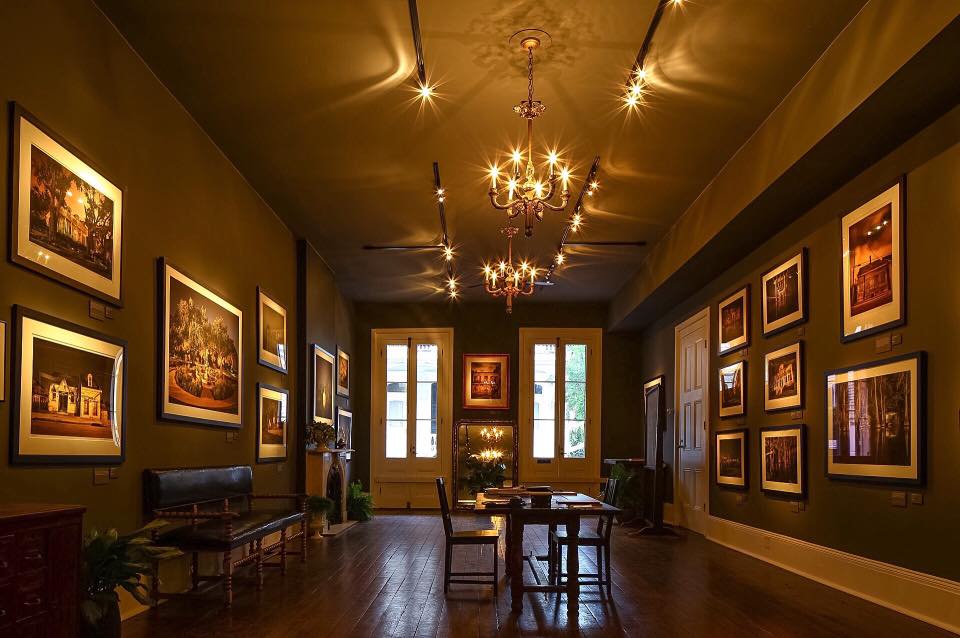
Photo courtesy of Frank Relle Photography on Facebook
Best known to visitors for her bars and restaurants, the French Quarter of New Orleans is also home to dozens of art galleries, constituting one of the greatest concentrations of studio space in the American South. In fact, the history and demographics that led to the Quarter becoming a hotbed of nightlife likely laid the foundation for its abundance of art galleries as well.
For decades, the Quarter’s historical buildings were seen as crumbling ruins. The confluence of creativity and cheap rents led to the arts taking hold in the Quarter, although said arts did not manifest as public gallery retail space in the beginning. The French Quarter was a bit too rough in her earlier days to accommodate a gallery scene, but as the neighborhood began offering more to visitors in the late 20th century, art spaces became a natural outgrowth of the local scene.
That’s not to ignore some truly steadfast art galleries that have held it down in the Quarter for what feels like ages. In any case, if you want to see local art, head to Royal Street, which is lined with galleries on multiple blocks. While it’s not as jam-packed as Royal, Chartres Street is also a mini mecca for art retail. Also, don’t miss the artists hawking their wares around the edges of Jackson Square, street artists throughout the Quarter, and Dirty Linen Night, an annual party that celebrates the Royal Street gallery scene.
Some notable local art galleries include:
Frank Relle Photography
910 Royal Street
One of the city’s most famous photographers, Frank Relle has made a career out of his love of New Orleans architecture, history, and light — or lack thereof, in the last case. Confused? Relle is best known for taking shots of New Orleans homes, buildings and street scenes late at night, using long exposures to create a singularly eerie (yet also oddly comforting, and always beautiful) micro genre of fine art photography.
Le Jardin
610/612 Royal Street
When we think of French Quarter art galleries, a place like Le Jardin often comes to mind. Effectively a narrow corridor that leads to a spacious dream of a Vieux Carre courtyard, all of the wall space in Le Jardin is crammed wall to groaning wall with the work of local artists. Much of the stuff you’ll see on display has a folk arty feel; the bright colors, bold presentation, locally focused subject matter and the general haphazard, slightly chaotic atmosphere of the place makes for an art experience that feels quintessentially New Orleans. While you’ll find original work here, there are plenty of prints as well. Also on site is Adorn, a local jewelry and crafts shop.
Gallery Burguieres
736 Royal Street
Ally Burguieres is passionate about both her art and the ethical treatment of animals, and has combined these interests into a gallery that is stuffed with paintings of animals. Some of these critters are engaged in almost anthropomorphic activities, and some are simply brought to life in a vibrant New Orleans color palette. You’ll also find art inspired by Alice in Wonderland and New Orleans street scenes. This gallery has many prints that can be purchased in lieu of original artwork; this may be a good idea if you have a kid (or kids) in tow, as children are often obsessed with Burguieres’ cute animal depictions.
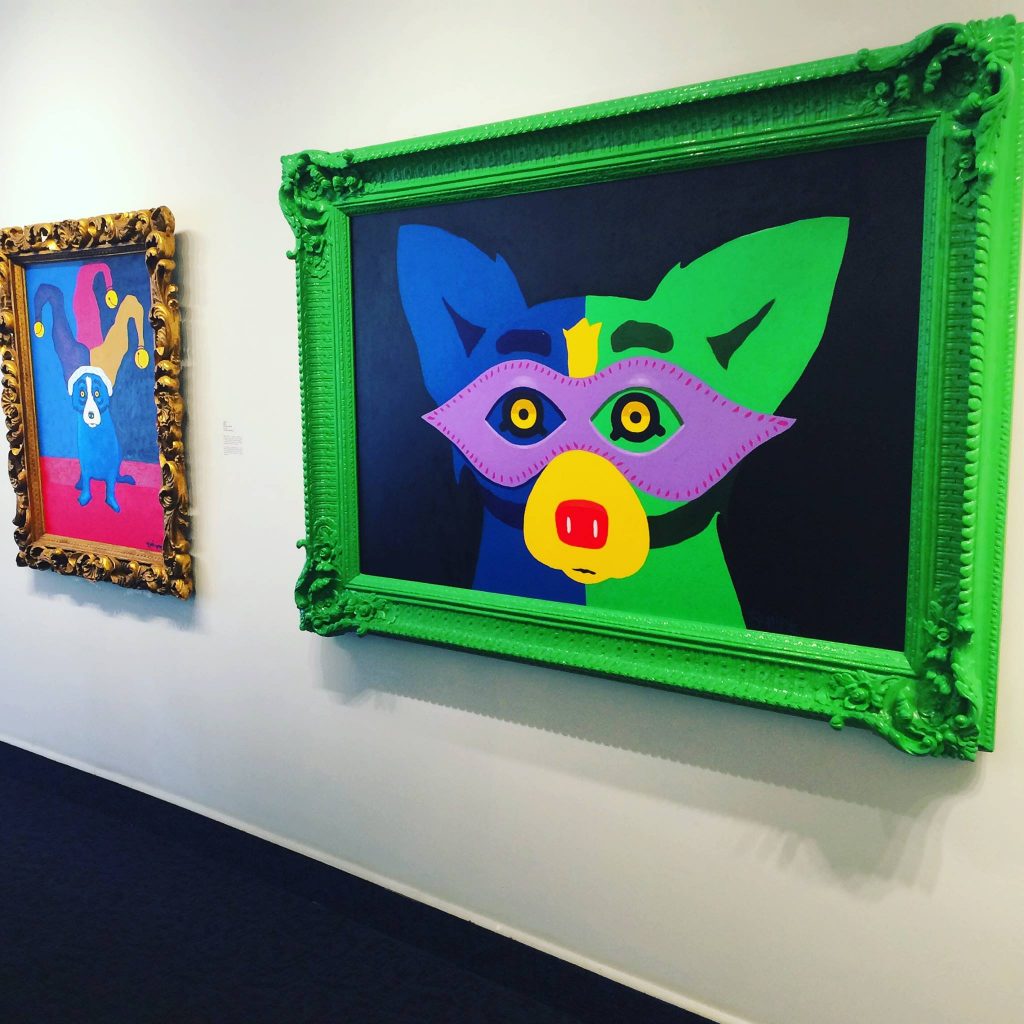
Photo courtesy of Art of George Rodrigue on Facebook
Rodrigue Studios
730 Royal Street
George Rodrigue, a native song of south Louisiana, was best known as the creator of the “Blue Dog,” perhaps the most recognizable symbol of Louisiana contemporary art. The dog, with its soulful yellow eyes, was first painted in 1984 for Bayou, a selection of Louisiana ghost stories released in conjunction with the 1984 World’s Fair, held in New Orleans. Rodrigue decided to paint a version of the Cajun loup garou, or werewolf, and in so doing created the ghostly visage of the Blue Dog. At once approachable, mysterious and riotously colorful, the Blue Dog would go on to become, in the eyes of the public, a stand-in for Cajun culture and Louisiana as a whole and the vehicle for Rodrigue’s considerable commercial success.
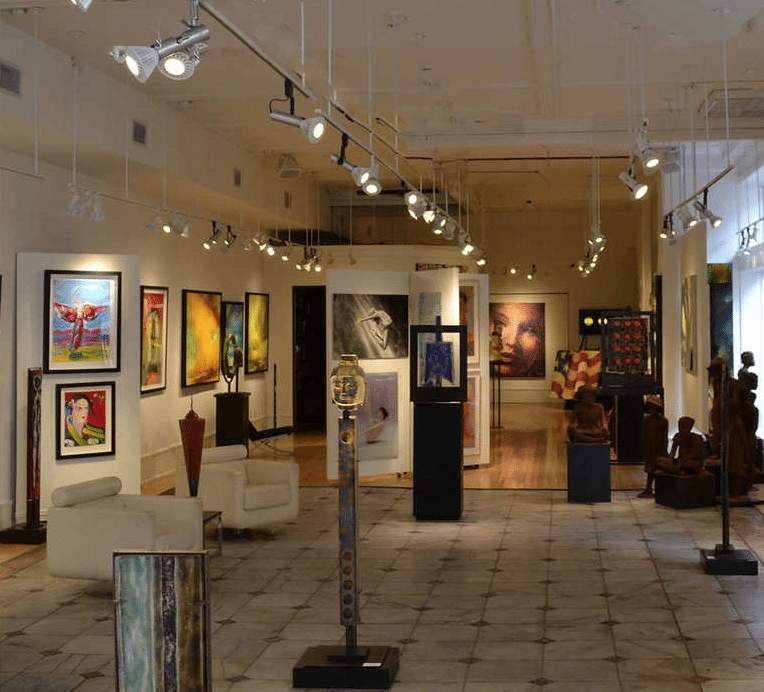
Photo courtesy of Angela King Gallery on Facebook
Angela King Gallery
241 Royal Street
Many visitors pigeonhole New Orleans art as big, bright and made for tourists, but this is hardly the case at the Angela King Gallery, one of the best contemporary art galleries in the city. At any one time, the gallery showcases the work of up to 30 artists, whose talents range from oil paintings to mixed media to ink sketches. This is an extremely varied, diverse gallery, and a great stop for visiting (and local) art lovers.
Scene by Rhys
1036 Royal Street
This gallery is a fine base for local artist and all-around character Emile Rhys. A supremely talented artist, Rhys is best known for her fine art ink and pen drawings of the city’s local musicians. Her work, which synthesizes two great elements of New Orleans creativity — the sonic world of music and the frenetic energy of her visual art — is unique and singularly worthy of souvenir consideration.
Are you planning to spend some time in New Orleans soon? To stay close to all the action, book a historic boutique hotel in the French Quarter at FrenchQuarter.com/hotels today!
Related Articles
JOIN THE NEWSLETTER!
French Quarter Shopping: The Best Perfumeries

New Orleans is often compared to a bewitching but temperamental woman. If that analogy is apt, then she’s also a perfumed one. From delicately fragrant honeysuckle and sweet olive to ghostly night-blooming cereus, floral scents hang heavy in New Orleans’ humid, subtropical air. They are as much a part of the city as pastel shotgun houses or the sound of a busker’s saxophone licks.
Although few senses are as subtle as the olfactory, the scent is also enormously evocative. Complex emotions and memories may be summoned from a whiff of freshly cut grass or hot apple pie. Why not include a bottle of perfume harnessing the essence of New Orleans among your souvenirs? You’ll make a fond memory when you purchase the perfume… and relive it every day when you apply it.
Bourbon French Parfums
805 Royal St.
Participate in a 180-year-old tradition when you browse for perfume at this quaint Royal Street shop. A specialist can custom-mix a unique fragrance tailored to your body chemistry, or you can take home a classic scent such as lilac, French lavender or musk. All perfumes are hand-mixed in small batches from natural ingredients.
Hové Perfumeur
434 Chartres St.
You’ll find a treasure trove of single-note floral perfumes at this elegant, high-ceilinged shop, some in distinctly old-fashioned scents like heliotrope and vetiver. There’s more to enjoy, though: bath salts, body powders, colognes, massage oil, and French-milled perfumed soaps. Tuck a beautifully wrapped bar in your luggage, and sweetly scented clothes will be your reward upon returning home. And get this: Founded in 1931, Hové is the oldest continuous perfumer manufacturer in New Orleans.
Lush
532 Royal St.
Yes, it’s a chain, but when the associates are this generous with samples and the product is both luxurious and eco-friendly, who can complain? Crafted in France of organic, vegetarian ingredients, each Lush perfume contains all-natural essential oils. Many feature coordinating lotions, soaps, shampoos, and bubble bars, so you can soak yourself in scent from head to toe. Spend an hour sampling the wares to see which suits you best.
Madame Aucoin Perfume
608 Bienville St.
Madame Aucoin is said to have been the first female perfumer in New Orleans, and today her legacy lives on in a modern boutique nestled in a former French Quarter residence. The carefully curated perfumes and colognes showcase a distinctive collection of niche and independent fragrance houses — primarily European, with standout scents from Australia and the UAE. Every fragrance is chosen with purpose, offering something for everyone.
Tijon New Orleans
631 Toulouse St.
Tijon is definitely a luxury, unique experience as you’ll be handed a lab coat and a workbook so you can create your own perfume. There are over 300 oils available, and you can bottle and name your own. Should you want to reorder in the future, Tijon will retain your formula. Tijon also offers classes, its own signature perfumes, and the New Orleans-inspired collection.
Are you planning to spend some time in New Orleans soon? To stay close to all the action, book a historic boutique hotel in the French Quarter at FrenchQuarter.com/hotels today!
Related Articles
JOIN THE NEWSLETTER!
Vintage Shopping in the French Quarter
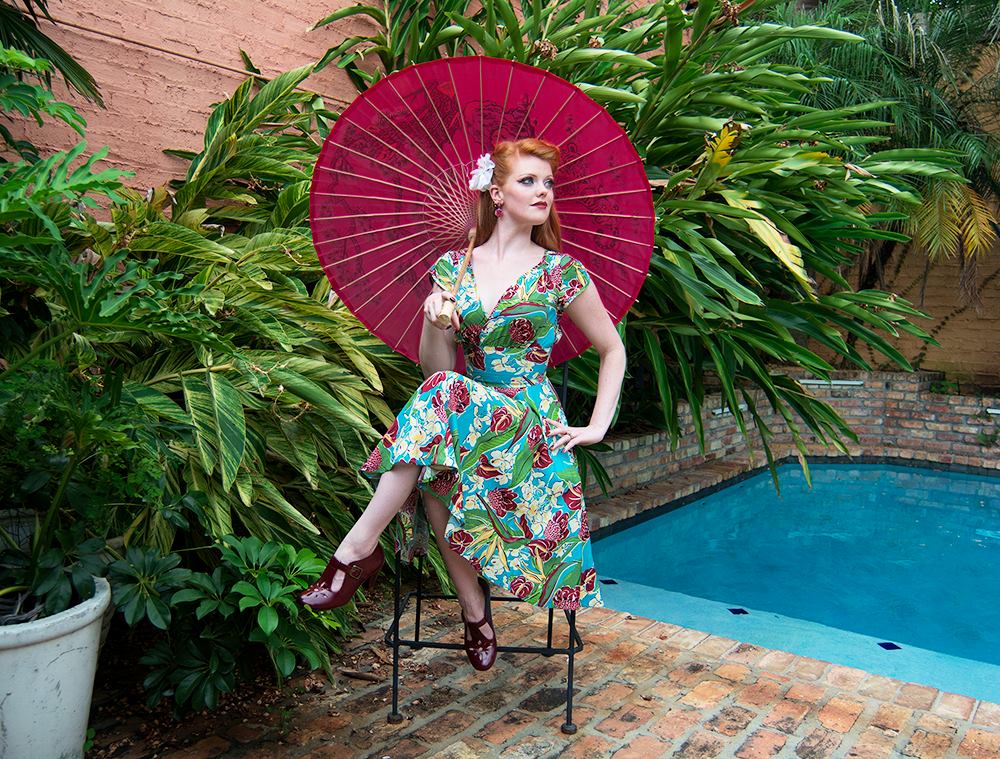
Photo courtesy of Trashy Diva on Facebook
It’s often said that a stroll through the French Quarter is like stepping back in time. Whether you’re viewing 18th-century buildings like the St. Louis Cathedral, or taking in 1940s-era music at a jazz club, it’s easy to feel transported to a different era. So why not dress to fit the theme? The Vieux Carre offers a host of vintage and vintage-inspired boutiques bursting with unique garments and accessories. There’s not much better than a wearable, one-of-a-kind souvenir — unless it’s the knowledge that vintage clothing is both timeless and eco-friendly. Here are a few must-stop vintage shops in the Quarter.
Dollz & Dames
216 Decatur St.
A funky retro-inspired boutique not unlike Trashy Diva, Dollz & Dames sells vintage-inspired clothing, shoes and accessories. (You can’t miss its eye candy of a storefront on an otherwise sleepy side of the block.) In addition to vintage- and retro-inspired stuff, there’s some true vintage and repurposed merch. It’s a treasure trove.
Lost and Found
323 Chartres St.
The same goes for Lost and Found, if you’re looking for some fun retro/pinup scores. The shop has plus sizes, accessories, kids’ clothes, costume bits like tutus petticoats, jewelry, socks, and much more.
Trashy Diva
537 Royal St. (also has a location Uptown at 2048 Magazine St.)
Launched in 1996 by owner Candice Gwinn as a vintage clothing shop, Trashy Diva gradually transitioned to become a purveyor of new, vintage-inspired clothing that takes its design cues from the 1920s, ’30s, ‘40s, and ‘50s. All the clothing is locally designed by Gwinn in New Orleans and manufactured in her private warehouse in China — so the light fabrics, vivid colors and dramatic prints are ideally suited to the local climate and traditions. (For example, a cotton voile sundress in a Mardi Gras-inspired print is a hot seller). The dresses are flattering and classic enough to warrant the investment. Available in sizes 0 through 24, they’ll be part of your wardrobe for years to come.
Are you planning to spend some time in New Orleans soon? To stay close to all the action, book a historic boutique hotel in the French Quarter at FrenchQuarter.com/hotels today!
Related Articles
JOIN THE NEWSLETTER!
5 Essential New Orleans Record Stores

LA Music Factory photo by Infrogmation of New Orleans on Flickr
Yes, you could fire up Spotify to stream your favorite New Orleans musicians — but the warmth, crackle and hiss of vinyl has so much more personality. (Not to mention that the beautifully designed sleeves can double as wall art.) Sometimes, music is best experienced both as an auditory and tangible product. For those times, here are a few standout record stores. You might just bring home a great souvenir — or discover a new favorite artist while flipping through the crates.
Euclid Records
3301 Chartres Street
This two-story, 4,000-square-foot music mecca in Bywater hosts frequent free in-store performances and movie nights. You can also sell your old CDs and LPs here.
Louisiana Music Factory
421 Frenchmen Street
Why not shop for music in the middle of a music district? You’ll find new and used records by local and national recording artists, T-shirts, music gear, magazines, and so much more.
No Pulp Records
228 Decatur Street
Located on the third floor of Beckham’s Bookshop in the heart of the French Quarter, No Pulp Records is well organized and is a must-stop for New Orleans-centric vinyl. The bookstore is a must-stop by itself, too.
Peaches Records
4318 Magazine Street
You’ll find this family-owned shop Uptown. The 15,000-square-foot store has a plethora of LPs, EPs, CDs, cassettes, merch, T-shirts, and miscellaneous gifts, including prayer candles.
The Mushroom
1037 Broadway Street
An Uptown mainstay for college students since 1970, this record store/head shop is dusty, incense-scented, and crammed with crates of records. It’s a pleasant way to while away an afternoon.
Are you planning to spend some time in New Orleans soon? To stay close to all the action, book a historic boutique hotel in the French Quarter at FrenchQuarter.com/hotels today!


